Thursday, August 19, 2010
For Kathrin Bringmann, who has been mentioned as a possible candidate for a Fields Medal.
The four Fields medal winners were announced today at the International Congress of Mathematicians in Hyderabad, India. Bringmann was not among them.
Bringmann was, however, the winner of the 2009 SASTRA Ramanujan Prize—
See The Hindu of September 30, 2009 and this journal on that date—


A Symbol of Apollo
For more about Bringmann's work, see an article on what has been called Ramanujan's "final problem."
For another problem with a claim to this title, see "Mathematician Untangles Legendary Problem" and search in this journal for Dyson + crank.
Comments Off on Consolation Prize
Saturday, August 7, 2010
For aficionados of mathematics and narrative —
Illustration from
"The Galois Quaternion— A Story"

This resembles an attempt by Coxeter in 1950 to represent
a Galois geometry in the Euclidean plane—
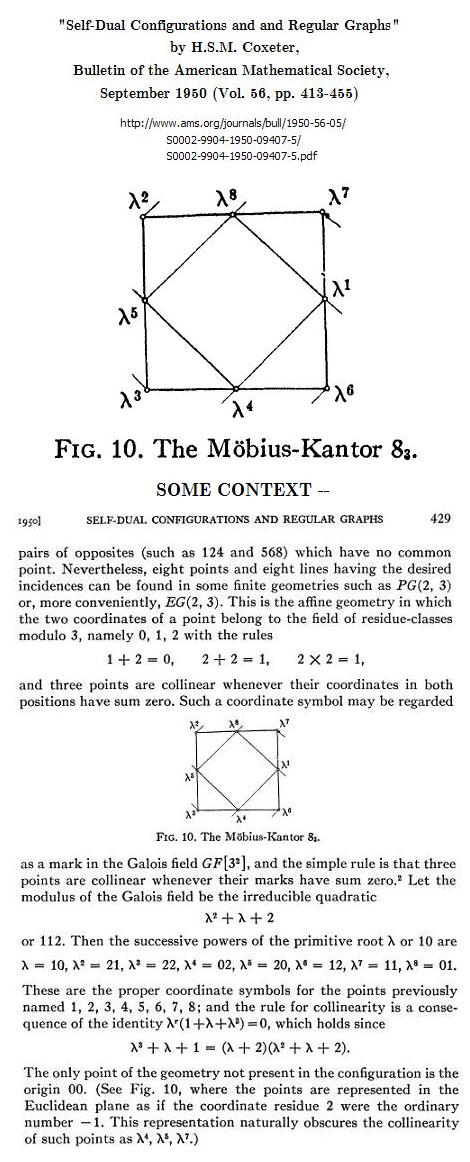
The quaternion illustration above shows a more natural way to picture this geometry—
not with dots representing points in the Euclidean plane, but rather with unit squares
representing points in a finite Galois affine plane. The use of unit squares to
represent points in Galois space allows, in at least some cases, the actions
of finite groups to be represented more naturally than in Euclidean space.
See Galois Geometry, Geometry Simplified, and
Finite Geometry of the Square and Cube.
Comments Off on The Matrix Reloaded
Tuesday, July 20, 2010
See Malcolm Lowry's "A corpse will be transported by express!" in this journal.
From June 23—
"When Plato regards geometry as the prerequisite to
philosophical knowledge, it is because geometry alone
renders accessible the realm of things eternal;
tou gar aei ontos he geometrike gnosis estin."
— Ernst Cassirer, Philosophy and Phenomenological Research,
Volume V, Number 1, September, 1944.
Maybe.
June 23, Midsummer Eve, was the date of death for Colonel Michael Cobb.
Cobb, who died aged 93, was "a regular Army officer who in retirement produced
the definitive historical atlas of the railways of Great Britain." — Telegraph.co.uk, July 19
As for geometry, railways, and things eternal, see parallel lines converging
in Tequila Mockingbird and Bedlam Songs.

The Rock Island Line’s namesake depot
in Rock Island, Illinois
See also Wallace Stevens on "the giant of nothingness"
in "A Primitive Like an Orb" and in Midsummer Eve's Dream—
At the center on the horizon, concentrum, grave
And prodigious person, patron of origins.
Comments Off on The Corpse Express
Monday, July 19, 2010
Part I —
A search for images of Wallace Stevens's "Pediment of Appearance"—
(Click to enlarge.)
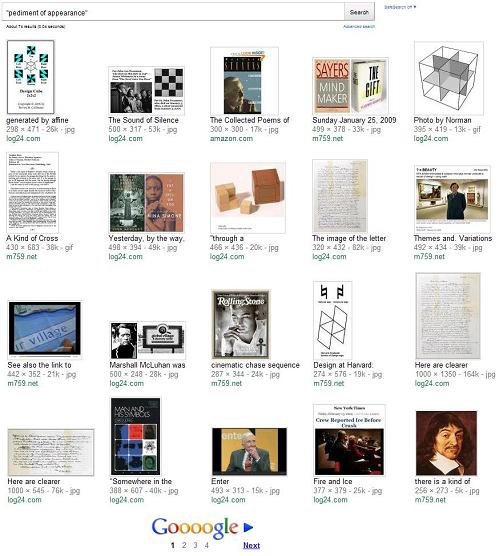
Part II —
A geometric analogue of the pediment—
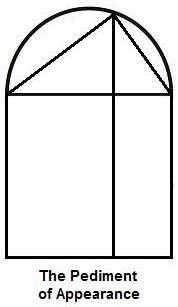
Note that the above cross also appears in
Euclid's proof of the Pythagorean theorem.
Part III —
An echo of the above geometry—
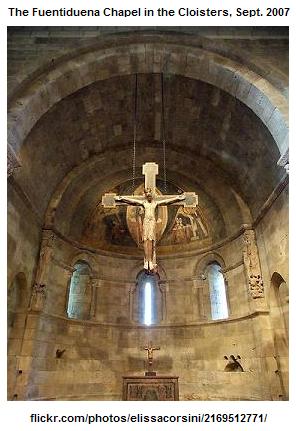
Comments Off on Pediments of Appearance
Thursday, July 15, 2010
"What exactly was Point Omega?"
This is Robert Wright in Nonzero: The Logic of Human Destiny.
Wright is discussing not the novel Point Omega by Don DeLillo,
but rather a (related) concept of the Jesuit philosopher Pierre Teilhard de Chardin.
My own idiosyncratic version of a personal "point omega"—

Click for further details.
The circular sculpture in the foreground
is called by the artist "The Omega Point."
This has been described as
"a portal that leads in or out of time and space."
For some other sorts of points, see the drawings
on the wall and Geometry Simplified—

The two points of the trivial affine space are represented by squares,
and the one point of the trivial projective space is represented by
a line segment separating the affine-space squares.
For related darkness at noon, see Derrida on différance
as a version of Plato's khôra—
(Click to enlarge.)

The above excerpts are from a work on and by Derrida
published in 1997 by Fordham University,
a Jesuit institution— Deconstruction in a Nutshell—

For an alternative to the Villanova view of Derrida,
see Angels in the Architecture.
Comments Off on Brightness at Noon, continued
Monday, July 12, 2010
Google Logo July 11, 2010—

"Oog" is Dutch (and Afrikaans) for "eye."
Strong Emergence Illustrated
(May 23, 2007 — Figures from Coxeter)—

The 2007 "strong emergence" post compares the
center figure to an "Ojo de Dios."
Comments Off on Eyes on the Prize
Saturday, July 10, 2010
Samuel Beckett on Dante and Joyce:
"Another point of comparison is the preoccupation
with the significance of numbers."
"If I'd been out 'til quarter to three
Would you lock the door,
Will you still need me, will you still feed me,
When I'm sixty-four?"

Happy birthday to Sue Lyon (Night of the Iguana, 1964)
Comments Off on Class of 64
In memory of an historian of Mexico
who died on Tuesday, July 6, 2010—

Related material—

and
Time Fold.
In the latter, click on
the link Eleven.
Comments Off on Quarter to Three, continued
Thursday, July 8, 2010
The following excerpts from Coxeter's Projective Geometry
sketch his attitude toward geometry in characteristic two.
"… we develop a self-contained account… made
more 'modern' by allowing the field to be general
(though not of characteristic 2) instead of real or complex."
The "modern" in quotation marks may have been an oblique
reference to Segre's Lectures on Modern Geometry (1948, 1961).
(See Coxeter's reference 15 below.)
Click to enlarge.

"It is interesting to see what happens…."
Another thing that happens if 1 + 1 = 0 —
It is no longer true that every finite reflection group
is a Coxeter group (provided we use Chevalley's
fixed-hyperplane definition of "reflection").
Comments Off on Coxeter vs. Fano
Tuesday, July 6, 2010
“Simplicity, simplicity, simplicity!
I say, let your affairs be as two or three,
and not a hundred or a thousand;
instead of a million count half a dozen,
and keep your accounts on your thumb-nail.”
— Henry David Thoreau, Walden
This quotation is the epigraph to
Section 1.1 of Alexandre V. Borovik’s
Mathematics Under the Microscope:
Notes on Cognitive Aspects of Mathematical Practice
(American Mathematical Society,
Jan. 15, 2010, 317 pages). |
From Peter J. Cameron’s review notes for
his new course in group theory—

From Log24 on June 24—
Geometry Simplified

(an affine space with subsquares as points
and sets of subsquares as hyperplanes)

(a projective space with, as points, sets
of line segments that separate subsquares)
Exercise—
Show that the above geometry is a model
for the algebra discussed by Cameron.
Comments Off on Window, continued
Sunday, July 4, 2010
24
*See also the theater section
of today's New York Times.
Comments Off on A Reappearing Number*
Thursday, July 1, 2010
Hoax and Hype
Four Years Ago Today—

There is Plato's diamond—

and there is diamond theory—

… but there is no "Plato's Diamond Theory."
See, however, today's noon entry, "Plato's Code."
"You gotta be true to your code…" —Sinatra
Comments Off on Darkness at Seven
John Allen Paulos yesterday at Twitter—
"Plato's code cracked?
Fascinating if not a hoax or hype."
3:43 AM Jun 30th via web
The story that Paulos linked to is about a British
academic who claims to have found some
symbolism hidden in Plato's writings by
splitting each into 12 parts and correlating
the 12 parts with semitones of a musical scale.
I prefer a different approach to Plato that is
related to the following hoax and hype—
HOAX:
From Dan Brown's novel Angels & Demons (2000)—

HYPE:
This four-elements diamond summarizes the classical
four elements and four qualities neatly, but some scholars
might call the figure "hype" since it deals with an academically
disreputable subject, alchemy, and since its origin is unclear.
For the four elements' role in some literature more respectable
than Dan Brown's, see Poetry's Bones.
Although an author like Brown might spin the remarks
below into a narrative— The Plato Code — they are
neither hoax nor hype.
NOT HOAX:

NOT HYPE:
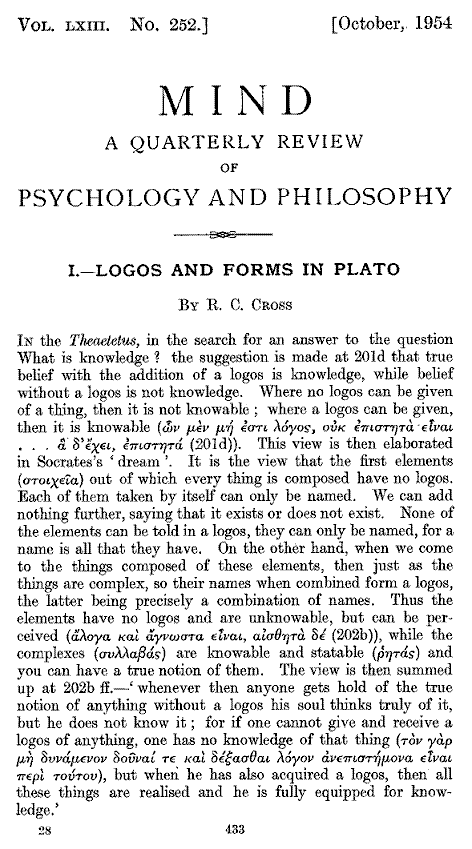
For related non-hoax, non-hype remarks, see
The Rational Enterprise: Logos in Plato's Theaetetus,
by Rosemary Desjardins.
Those who prefer hoax and hype in their philosophy may consult
the writings of, say, Barbara Johnson, Rosalind Krauss, and—
in yesterday's NY Times's "The Stone" column— Nancy Bauer.

— The New York Times
Comments Off on Plato’s Code
Wednesday, June 30, 2010
In memory of Wu Guanzhong, Chinese artist who died in Beijing on Friday—

"Once Knecht confessed to his teacher that he wished to learn enough to be able to incorporate the system of the I Ching into the Glass Bead Game. Elder Brother laughed. 'Go ahead and try,' he exclaimed. 'You'll see how it turns out. Anyone can create a pretty little bamboo garden in the world. But I doubt that the gardener would succeed in incorporating the world in his bamboo grove.'"
— Hermann Hesse, The Glass Bead Game, translated by Richard and Clara Winston
"The Chinese painter Wu Tao-tzu was famous because he could paint nature in a unique realistic way that was able to deceive all who viewed the picture. At the end of his life he painted his last work and invited all his friends and admirers to its presentation. They saw a wonderful landscape with a romantic path, starting in the foreground between flowers and moving through meadows to high mountains in the background, where it disappeared in an evening fog. He explained that this picture summed up all his life’s work and at the end of his short talk he jumped into the painting and onto the path, walked to the background and disappeared forever."
— Jürgen Teichmann. Teichmann notes that "the German poet Hermann Hesse tells a variation of this anecdote, according to his own personal view, as found in his 'Kurzgefasster Lebenslauf,' 1925."
Comments Off on Field Dream
Saturday, June 26, 2010
"The present study is closely connected with a lecture* given by Prof. Ernst Cassirer at the Warburg Library whose subject was 'The Idea of the Beautiful in Plato's Dialogues'…. My investigation traces the historical destiny of the same concept…."
* See Cassirer's Eidos und Eidolon : Das Problem des Schönen und der Kunst in Platons Dialogen, in Vorträge der Bibliothek Warburg II, 1922/23 (pp. 1–27). Berlin and Leipzig, B.G. Teubner, 1924.
— Erwin Panofsky, Idea: A Concept in Art Theory, foreword to the first German edition, Hamburg, March 1924
On a figure from Plato's Meno—

The above figures illustrate Husserl's phrase "eidetic variation"—
a phrase based on Plato's use of eidos, a word
closely related to the word "idea" in Panofsky's title.
For remarks by Cassirer on the theory of groups, a part of
mathematics underlying the above diamond variations, see
his "The Concept of Group and the Theory of Perception."
Sketch of some further remarks—

The Waterfield question in the sketch above
is from his edition of Plato's Theaetetus
(Penguin Classics, 1987).
The "design theory" referred to in the sketch
is that of graphic design, which includes the design
of commercial logos. The Greek word logos
has more to do with mathematics and theology.
"If there is one thread of warning that runs
through this dialogue, from beginning to end,
it is that verbal formulations as such are
shot through with ambiguity."
— Rosemary Desjardins, The Rational Enterprise:
Logos in Plato's Theaetetus, SUNY Press, 1990
Related material—
(Click to enlarge.)

Comments Off on Plato’s Logos
Thursday, June 24, 2010
Geometry Simplified

(a projective space)
The above finite projective space
is the simplest nontrivial example
of a Galois geometry (i.e., a finite
geometry with coordinates in a
finite (that is, Galois) field.)
The vertical (Euclidean) line represents a
(Galois) point, as does the horizontal line
and also the vertical-and-horizontal
cross that represents the first two points'
binary sum (i.e., symmetric difference,
if the lines are regarded as sets).
Homogeneous coordinates for the
points of this line —
(1,0), (0,1), (1,1).
Here 0 and 1 stand for the elements
of the two-element Galois field GF(2).
The 3-point line is the projective space
corresponding to the affine space
(a plane, not a line) with four points —

(an affine space)
The (Galois) points of this affine plane are
not the single and combined (Euclidean)
line segments that play the role of
points in the 3-point projective line,
but rather the four subsquares
that the line segments separate.
For further details, see Galois Geometry.
There are, of course, also the trivial
two-point affine space and the corresponding
trivial one-point projective space —

Here again, the points of the affine space are
represented by squares, and the point of the
projective space is represented by a line segment
separating the affine-space squares.
Comments Off on Midsummer Noon
Monday, June 21, 2010
From a post by Ivars Peterson, Director
of Publications and Communications at
the Mathematical Association of America,
at 19:19 UTC on June 19, 2010—
Exterior panels and detail of panel,
Michener Gallery at Blanton Museum
in Austin, Texas—

Peterson associates the four-diamond figure
with the Pythagorean theorem.
A more relevant association is the
four-diamond view of a tesseract shown here
on June 19 (the same date as Peterson's post)
in the "Imago Creationis" post—

This figure is relevant because of a
tesseract sculpture by Peter Forakis—

This sculpture was apparently shown in the above
building— the Blanton Museum's Michener gallery—
as part of the "Reimagining Space" exhibition,
September 28, 2008-January 18, 2009.
The exhibition was organized by
Linda Dalrymple Henderson, Centennial Professor
in Art History at the University of Texas at Austin
and author of The Fourth Dimension and
Non-Euclidean Geometry in Modern Art
(Princeton University Press, 1983;
new ed., MIT Press, 2009).
For the sculptor Forakis in this journal,
see "The Test" (December 20, 2009).
"There is such a thing
as a tesseract."
— A Wrinkle in TIme
Comments Off on Test
This journal’s 11 AM Sunday post was “Lovasz Wins Kyoto Prize.” This is now the top item on the American Mathematical Society online home page—

Click to enlarge.
For more background on Lovasz, see today’s
previous Log24 post, Cube Spaces, and also
Cube Space, 1984-2003.
“If the Party could thrust its hand into the past and
… say of this or that event, it never happened….”
— George Orwell, 1984
Comments Off on 1984 Story (continued)
Cubic models of finite geometries
display an interplay between
Euclidean and Galois geometry.
Example 1— The 2×2×2 Cube—
also known as the eightfold cube—

Group actions on the eightfold cube, 1984—

Version by Laszlo Lovasz et al., 2003—

Lovasz et al. go on to describe the same group actions
as in the 1984 note, without attribution.
Example 2— The 3×3×3 Cube
A note from 1985 describing group actions on a 3×3 plane array—

Undated software by Ed Pegg Jr. displays
group actions on a 3×3×3 cube that extend the
3×3 group actions from 1985 described above—

Pegg gives no reference to the 1985 work on group actions.
Example 3— The 4×4×4 Cube
A note from 27 years ago today—

As far as I know, this version of the
group-actions theorem has not yet been ripped off.
Comments Off on Cube Spaces
Sunday, June 20, 2010
From a June 18 press release—
KYOTO, Japan, Jun 18, 2010 (BUSINESS WIRE) — The non-profit Inamori Foundation (President: Dr. Kazuo Inamori) today announced that Dr. Laszlo Lovasz will receive its 26th annual Kyoto Prize in Basic Sciences, which for 2010 focuses on the field of Mathematical Sciences. Dr. Lovasz, 62, a citizen of both Hungary and the United States, will receive the award for his outstanding contributions to the advancement of both the academic and technological possibilities of the mathematical sciences.
Dr. Lovasz currently serves as both director of the Mathematical Institute at Eotvos Lorand University in Budapest and as president of the International Mathematics Union. Among many positions held throughout his distinguished career, Dr. Lovasz also served as a senior research member at Microsoft Research Center and as a professor of computer science at Yale University.
Related material: Cube Space, 1984-2003.
See also “Kyoto Prize” in this journal—
The Kyoto Prize is “administered by the Inamori Foundation, whose president, Kazuo Inamori, is founder and chairman emeritus of Kyocera and KDDI Corporation, two Japanese telecommunications giants.”
— – Montreal Gazette, June 20, 2008


Fly from Fly Bottle
Comments Off on Lovasz Wins Kyoto Prize
Saturday, June 19, 2010

In the above view, four of the tesseract's 16
vertices are overlaid by other vertices.
For views that are more complete and
moveable, see Smith's tesseract page.
Four-Part Tesseract Divisions—

The above figure shows how four-part partitions
of the 16 vertices of a tesseract in an infinite
Euclidean space are related to four-part partitions
of the 16 points in a finite Galois space
Euclidean spaces versus Galois spaces
in a larger context—
Infinite versus Finite
The central aim of Western religion —
"Each of us has something to offer the Creator...
the bridging of
masculine and feminine,
life and death.
It's redemption.... nothing else matters."
-- Martha Cooley in The Archivist (1998)
The central aim of Western philosophy —
Dualities of Pythagoras
as reconstructed by Aristotle:
Limited Unlimited
Odd Even
Male Female
Light Dark
Straight Curved
... and so on ....
"Of these dualities, the first is the most important; all the others may be seen as different aspects of this fundamental dichotomy. To establish a rational and consistent relationship between the limited [man, etc.] and the unlimited [the cosmos, etc.] is… the central aim of all Western philosophy."
— Jamie James in The Music of the Spheres (1993)
|
Another picture related to philosophy and religion—
Jung's Four-Diamond Figure from Aion—

This figure was devised by Jung
to represent the Self. Compare the
remarks of Paul Valéry on the Self—
|
Flight from Eden: The Origins of Modern Literary Criticism and Theory, by Steven Cassedy, U. of California Press, 1990, pages 156-157—
Valéry saw the mind as essentially a relational system whose operation he attempted to describe in the language of group mathematics. "Every act of understanding is based on a group," he says (C, 1:331). "My specialty— reducing everything to the study of a system closed on itself and finite" (C, 19: 645). The transformation model came into play, too. At each moment of mental life the mind is like a group, or relational system, but since mental life is continuous over time, one "group" undergoes a "transformation" and becomes a different group in the next moment. If the mind is constantly being transformed, how do we account for the continuity of the self? Simple; by invoking the notion of the invariant. And so we find passages like this one: "The S[elf] is invariant, origin, locus or field, it's a functional property of consciousness" (C, 15:170 [2:315]). Just as in transformational geometry, something remains fixed in all the projective transformations of the mind's momentary systems, and that something is the Self (le Moi, or just M, as Valéry notates it so that it will look like an algebraic variable). Transformation theory is all over the place. "Mathematical science… reduced to algebra, that is, to the analysis of the transformations of a purely differential being made up of homogeneous elements, is the most faithful document of the properties of grouping, disjunction, and variation in the mind" (O, 1:36). "Psychology is a theory of transformations, we just need to isolate the invariants and the groups" (C, 1:915). "Man is a system that transforms itself" (C, 2:896).
Notes:
O Paul Valéry, Oeuvres (Paris: Pléiade, 1957-60)
C Valéry, Cahiers, 29 vols. (Paris: Centre National de le Recherche Scientifique, 1957-61)
|
Note also the remarks of George David Birkhoff at Rice University
in 1940 (pdf) on Galois's theory of groups and the related
"theory of ambiguity" in Galois's testamentary letter—
|
… metaphysical reasoning always relies on the Principle of Sufficient Reason, and… the true meaning of this Principle is to be found in the “Theory of Ambiguity” and in the associated mathematical “Theory of Groups.”
If I were a Leibnizian mystic, believing in his “preestablished harmony,” and the “best possible world” so satirized by Voltaire in “Candide,” I would say that the metaphysical importance of the Principle of Sufficient Reason and the cognate Theory of Groups arises from the fact that God thinks multi-dimensionally* whereas men can only think in linear syllogistic series, and the Theory of Groups is the appropriate instrument of thought to remedy our deficiency in this respect.
* That is, uses multi-dimensional symbols beyond our grasp.
|
Related material:
Imago Creationis—
A medal designed by Leibniz to show how
binary arithmetic mirrors the creation by God
of something (1) from nothing (0).

Another array of 16 strings of 0's and 1's, this time
regarded as coordinates rather than binary numbers—
Frame of Reference

The Diamond Theorem—

Some context by a British mathematician —

|
Imago
by Wallace Stevens
Who can pick up the weight of Britain,
Who can move the German load
Or say to the French here is France again?
Imago. Imago. Imago.
It is nothing, no great thing, nor man
Of ten brilliancies of battered gold
And fortunate stone. It moves its parade
Of motions in the mind and heart,
A gorgeous fortitude. Medium man
In February hears the imagination's hymns
And sees its images, its motions
And multitudes of motions
And feels the imagination's mercies,
In a season more than sun and south wind,
Something returning from a deeper quarter,
A glacier running through delirium,
Making this heavy rock a place,
Which is not of our lives composed . . .
Lightly and lightly, O my land,
Move lightly through the air again.
|
Comments Off on Imago Creationis
Wednesday, June 16, 2010
David Levine's portrait of Arthur Koestler (see Dec. 30, 2009) —


Escher’s Verbum

Solomon’s Cube

Geometry of the I Ching
See also this morning's post as well as
Monday's post quoting George David Birkhoff —
"If I were a Leibnizian mystic… I would say that…
God thinks multi-dimensionally — that is,
uses multi-dimensional symbols beyond our grasp."
Comments Off on Brightness at Noon
Tuesday, June 15, 2010
Recommended— an online book—
Flight from Eden: The Origins of Modern Literary Criticism and Theory,
by Steven Cassedy, U. of California Press, 1990.
See in particular
Pages 156-157—
Valéry saw the mind as essentially a relational system whose operation he attempted to describe in the language of group mathematics. “Every act of understanding is based on a group,” he says (C, 1:331). “My specialty—reducing everything to the study of a system closed on itself and finite” (C, 19: 645). The transformation model came into play, too. At each moment of mental life the mind is like a group, or relational system, but since mental life is continuous over time, one “group” undergoes a “transformation” and becomes a different group in the next moment. If the mind is constantly being transformed, how do we account for the continuity of the self? Simple; by invoking the notion of the invariant. And so we find passages like this one: “The S[elf] is invariant, origin, locus or field, it’s a functional property of consciousness” (C, 15:170 [2: 315]). Just as in transformational geometry, something remains fixed in all the projective transformations of the mind’s momentary systems, and that something is the Self (le Moi, or just M, as Valéry notates it so that it will look like an algebraic variable). Transformation theory is all over the place. “Mathematical science . . . reduced to algebra, that is, to the analysis of the transformations of a purely differential being made up of homogeneous elements, is the most faithful document of the properties of grouping, disjunction, and variation in the mind” (O, 1:36). “Psychology is a theory of transformations, we just need to isolate the invariants and the groups” (C, 1:915). “Man is a system that transforms itself” (C, 2:896).
Notes:
O Paul Valéry, Oeuvres (Paris: Pléiade, 1957-60)
C Valéry, Cahiers, 29 vols. (Paris: Centre National de le Recherche Scientifique, 1957-61)
Compare Jung’s image in Aion of the Self as a four-diamond figure:

and Cullinane’s purely geometric four-diamond figure:

For a natural group of 322,560 transformations acting on the latter figure, see the diamond theorem.
What remains fixed (globally, not pointwise) under these transformations is the system of points and hyperplanes from the diamond theorem. This system was depicted by artist Josefine Lyche in her installation “Theme and Variations” in Oslo in 2009. Lyche titled this part of her installation “The Smallest Perfect Universe,” a phrase used earlier by Burkard Polster to describe the projective 3-space PG(3,2) that contains these points (at right below) and hyperplanes (at left below).

Although the system of points (at right above) and hyperplanes (at left above) exemplifies Valéry’s notion of invariant, it seems unlikely to be the sort of thing he had in mind as an image of the Self.
Comments Off on Imago, Imago, Imago
Friday, June 4, 2010
Today's New York Times—
Art Review
(“Yves Klein: With the Void, Full Powers”
runs through Sept. 12 at the Hirshhorn.)
Related material—
Search this journal for klein + paris.
See also Art Space (May 22, 2010)—
Comments Off on ART WARS continued
Monday, May 31, 2010
… and for Louise Bourgeois

"The épateurs were as boring as the bourgeois,
two halves of one dreariness."
— D. H. Lawrence, The Plumed Serpent

Comments Off on Memorial for Galois
Thursday, May 27, 2010
"You ain't been blue; no, no, no.
You ain't been blue,
Till you've had that mood indigo."
— Song lyrics, authorship disputed
Indigo (web color) (#4B0082)
"Pigment indigo (web color indigo) represents
the way the color indigo was always reproduced
in pigments, paints, or colored pencils in the 1950s."
Related mythology:
Indigo Children and the classic
1964 film Children of the Damned

Related non-mythology:
Colored pencils—

Comments Off on A Gathering for Gardner
Saturday, May 22, 2010
From an interview with artist Josefine Lyche (see previous post) dated March 11, 2009—
– Can you name a writer or book, fiction or theory that has inspired your works?
– Right now I am reading David Foster Wallace, which is great and inspiring. Others would be Aleister Crowley, Terence McKenna, James Joyce, J.L Borges, J.D Ballard, Stanislaw Lem, C. S. Lewis and Plato to mention some. Books, both fiction and theory are a great part of my life and work.
This journal on the date of the interview had a post about a NY Times story, ”Paris | A Show About Nothing."
Related images—
“Space: what you damn well have to see.”
– James Joyce, Ulysses
Comments Off on Art Space
Friday, May 21, 2010
From an art exhibition in Oslo last year–

The artist's description above is not in correct left-to-right order.
Actually the hyperplanes above are at left, the points at right.
Compare to "Picturing the Smallest Projective 3-Space,"
a note of mine from April 26, 1986—

Click for the original full version.
Compare also to Burkard Polster's original use of
the phrase "the smallest perfect universe."
Polster's tetrahedral model of points and hyperplanes
is quite different from my own square version above.
See also Cullinane on Polster.
Here are links to the gallery press release
and the artist's own photos.
Comments Off on The Oslo Version
Thursday, May 20, 2010

Pictorial version
of Hexagram 20,
Contemplation (View)
Related material:
A Handful of Dust
by J. G. Ballard
Comments Off on View
Saturday, May 15, 2010
Comments Off on Mathematics and Narrative continued…
Friday, May 14, 2010
A recently created Wikipedia article says that “The Miracle Octad Generator [MOG] is an array of coordinates, arranged in four rows and six columns, capable of describing any point in 24-dimensional space….” (Clearly any array with 24 parts is so capable.) The article ignores the fact that the MOG, as defined by R.T. Curtis in 1976, is not an array of coordinates, but rather a picture of a correspondence between two sets, each containing 35 structures. (As a later commentator has remarked, this correspondence is a well-known one that preserves a certain incidence property. See Eightfold Geometry.)
From the 1976 paper defining the MOG—
“There is a correspondence between the two systems of 35 groups, which is illustrated in Fig. 4 (the MOG or Miracle Octad Generator).” —R.T. Curtis, “A New Combinatorial Approach to M24,” Mathematical Proceedings of the Cambridge Philosophical Society (1976), 79: 25-42

Curtis’s 1976 Fig. 4. (The MOG.)
The Wikipedia article, like a similar article at PlanetMath, is based on a different definition, from a book first published in 1988—

I have not seen the 1973 Curtis paper, so I do not know whether it uses the 35-sets correspondence definition or the 6×4 array definition. The remarks of Conway and Sloane on page 312 of the 1998 edition of their book about “Curtis’s original way of finding octads in the MOG [Cur2]” indicate that the correspondence definition was the one Curtis used in 1973—

Here the picture of “the 35 standard sextets of the MOG”
is very like (modulo a reflection) Curtis’s 1976 picture
of the MOG as a correspondence between two 35-sets.
A later paper by Curtis does use the array definition. See “Further Elementary Techniques Using the Miracle Octad Generator,” Proceedings of the Edinburgh Mathematical Society (1989) 32, 345-353.
The array definition is better suited to Conway’s use of his hexacode to describe octads, but it obscures the close connection of the MOG with finite geometry. That connection, apparent in the phrases “vector space structure in the standard square” and “parallel 2-spaces” (Conway and Sloane, third ed., p. 312, illustrated above), was not discussed in the 1976 Curtis paper. See my own page on the MOG at finitegeometry.org.
Comments Off on Competing MOG Definitions
Tuesday, May 4, 2010
Romancing the
Non-Euclidean Hyperspace
Backstory —
Mere Geometry, Types of Ambiguity,
Dream Time, and Diamond Theory, 1937

For the 1937 grid, see Diamond Theory, 1937.
The grid is, as Mere Geometry points out, a non-Euclidean hyperspace.
For the diamonds of 2010, see Galois Geometry and Solomon’s Cube.
Comments Off on Mathematics and Narrative, continued
Thursday, April 29, 2010
Mathematics and Narrative
(continued from April 26 and 28):
The Web

See also
Leiber's Big Time, Spider Woman, and The Eight.
Comments Off on Spider Woman
Tuesday, March 16, 2010
New Game
In memory of a Jesuit who died on February 22 (see yesterday's "For the Ides of March")–
“The Game in the Ship cannot be approached as a job, a vocation, a career, or a recreation. To the contrary, it is Life and Death itself at work there. In the Inner Game, we call the Game Dhum Welur, the Mind of God."
— M. A. Foster, The Gameplayers of Zan
"… for Othello, no less than his creator Shakespeare, death without speechmaking is almost unthinkable."
— "Walter Ong," by Jeet Heer (Book & Culture, July/August 2004)
"This Jack, joke, poor potsherd, patch, matchwood…."
— Jesuit quote at David Lavery's weblog today
See also this journal on February 22, the date of the Jesuit death. A post on that date mentions Ong and his teacher McLuhan, and displays a McLuhan figure related to the "joke" quote above–
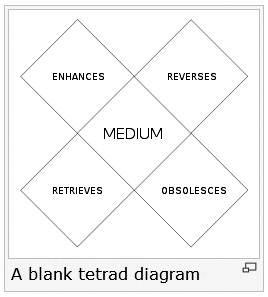
Click figure for background.
Ong discussed "agonistic" culture.
See "Sunday's Theater" and a film
based on the novel discussed there–

Classics 101 –

Prof. Coleman Silk introduces
freshmen to academic values
For academic gameplayers who prefer
less emotionally challenging subjects,
there is Othello Online —

"New Game. You May Pass for White to Start."
Comments Off on Gameplayers of the Academy
Monday, March 15, 2010
Kugelbild
"You are retracing your steps."
— Jacques Derrida

www.yourmuseumstore.com
See also today's update (scroll down)
to Half-Circle Patterns as well as
Angels and Demons and Symbology.
Comments Off on But Seriously…
Wednesday, March 3, 2010
Jeremy Gray, Plato's Ghost: The Modernist Transformation of Mathematics, Princeton, 2008–
"Here, modernism is defined as an autonomous body of ideas, having little or no outward reference, placing considerable emphasis on formal aspects of the work and maintaining a complicated— indeed, anxious— rather than a naïve relationship with the day-to-day world, which is the de facto view of a coherent group of people, such as a professional or discipline-based group that has a high sense of the seriousness and value of what it is trying to achieve. This brisk definition…."
Brisk? Consider Caesar's "The die is cast," Gray in "Solomon's Cube," and yesterday's post—

This is the group of "8 rigid motions
generated by reflections in midplanes"
of Solomon's Cube.
Related material:
"… the action of G168 in its alternative guise as SL(3; Z/2Z) is also now apparent. This version of G168 was presented by Weber in [1896, p. 539],* where he attributed it to Kronecker."
— Jeremy Gray, "From the History of a Simple Group," in The Eightfold Way, MSRI Publications, 1998
Here MSRI, an acronym for Mathematical Sciences Research Institute, is pronounced "Misery." See Stephen King, K.C. Cole, and Heinrich Weber.
*H. Weber, Lehrbuch der Algebra, Vieweg, Braunschweig, 1896. Reprinted by Chelsea, New York, 1961.
Comments Off on Plato’s Ghost
Monday, March 1, 2010
The current article on group theory at Wikipedia has a Rubik's Cube as its logo–

The article quotes Nathan C. Carter on the question "What is symmetry?"
This naturally suggests the question "Who is Nathan C. Carter?"
A search for the answer yields the following set of images…

Click image for some historical background.
Carter turns out to be a mathematics professor at Bentley University. His logo– an eightfold-cube labeling (in the guise of a Cayley graph)– is in much better taste than Wikipedia's.
Comments Off on Visual Group Theory
Saturday, February 27, 2010
"The cube has…13 axes of symmetry:
6 C2 (axes joining midpoints of opposite edges),
4 C3 (space diagonals), and
3C4 (axes joining opposite face centroids)."
–Wolfram MathWorld article on the cube
These 13 symmetry axes can be used to illustrate the interplay between Euclidean and Galois geometry in a cubic model of the 13-point Galois plane.
The geometer's 3×3×3 cube–
27 separate subcubes unconnected
by any Rubik-like mechanism–

The 13 symmetry axes of the (Euclidean) cube–
exactly one axis for each pair of opposite
subcubes in the (Galois) 3×3×3 cube–

A closely related structure–
the finite projective plane
with 13 points and 13 lines–

A later version of the 13-point plane
by Ed Pegg Jr.–

A group action on the 3×3×3 cube
as illustrated by a Wolfram program
by Ed Pegg Jr. (undated, but closely
related to a March 26, 1985 note
by Steven H. Cullinane)–

The above images tell a story of sorts.
The moral of the story–
Galois projective geometries can be viewed
in the context of the larger affine geometries
from which they are derived.
The standard definition of points in a Galois projective plane is that they are lines through the (arbitrarily chosen) origin in a corresponding affine 3-space converted to a vector 3-space.
If we choose the origin as the center cube in coordinatizing the 3×3×3 cube (See Weyl's relativity problem ), then the cube's 13 axes of symmetry can, if the other 26 cubes have properly (Weyl's "objectively") chosen coordinates, illustrate nicely the 13 projective points derived from the 27 affine points in the cube model.
The 13 lines of the resulting Galois projective plane may be derived from Euclidean planes through the cube's center point that are perpendicular to the cube's 13 Euclidean symmetry axes.
The above standard definition of points in a Galois projective plane may of course also be used in a simpler structure– the eightfold cube.
(The eightfold cube also allows a less standard way to picture projective points that is related to the symmetries of "diamond" patterns formed by group actions on graphic designs.)
See also Ed Pegg Jr. on finite geometry on May 30, 2006
at the Mathematical Association of America.
Comments Off on Cubist Geometries
Monday, February 22, 2010
The Medium is the Message

Marshall McLuhan
From the Wikipedia article
on Marshall McLuhan–

From yesterday—
(Click images for some background.)

Related material:
Feast of St. Louis, 2003,
a web page on McLuhan's
student Walter J. Ong, S. J.,
and Jung and the Imago Dei
Comments Off on Annals of Philosophy
Sunday, February 21, 2010
From the Wikipedia article "Reflection Group" that I created on Aug. 10, 2005— as revised on Nov. 25, 2009—
|
Historically, (Coxeter 1934) proved that every reflection group [Euclidean, by the current Wikipedia definition] is a Coxeter group (i.e., has a presentation where all relations are of the form ri2 or (rirj)k), and indeed this paper introduced the notion of a Coxeter group, while (Coxeter 1935) proved that every finite Coxeter group had a representation as a reflection group [again, Euclidean], and classified finite Coxeter groups.
Finite fields
When working over finite fields, one defines a "reflection" as a map that fixes a hyperplane (otherwise for example there would be no reflections in characteristic 2, as −1=1 so reflections are the identity). Geometrically, this amounts to including shears in a hyperplane. Reflection groups over finite fields of characteristic not 2 were classified in (Zalesskiĭ & Serežkin 1981).
|
Related material:
"A Simple Reflection Group of Order 168," by Steven H. Cullinane, and
"Determination of the Finite Primitive Reflection Groups over an Arbitrary Field of Characteristic Not 2,"
by Ascher Wagner, U. of Birmingham, received 27 July 1977
| Journal |
Geometriae Dedicata |
| Publisher |
Springer Netherlands |
| Issue |
Volume 9, Number 2 / June, 1980 |

[A primitive permuation group preserves
no nontrivial partition of the set it acts upon.]
Clearly the eightfold cube is a counterexample.
Comments Off on Reflections
Friday, February 19, 2010
Deep Play:
Mimzy vs. Mimsy
From a 2007 film, "The Last Mimzy," based on
the classic 1943 story by Lewis Padgett
"Mimsy Were the Borogoves"–

As the above mandala pictures show,
the film incorporates many New Age fashions.
The original story does not.
A more realistic version of the story
might replace the mandalas with
the following illustrations–

Click to enlarge.
For a commentary, see "Non-Euclidean Blocks."
(Here "non-Euclidean" means simply
other than Euclidean. It does not imply any
violation of Euclid's parallel postulate.)
Comments Off on Mimzy vs. Mimsy
Sunday, February 14, 2010
"Simplify, simplify." — Henry David Thoreau
"Because of their truly fundamental role in mathematics, even the simplest diagrams concerning finite reflection groups (or finite mirror systems, or root systems– the languages are equivalent) have interpretations of cosmological proportions."
— Alexandre Borovik, 2010 (See previous entry.)
Exercise: Discuss Borovik's remark
that "the languages are equivalent"
in light of the web page

A Simple Reflection Group
of Order 168.
Background:
Theorems 15.1 and 15.2 of Borovik's book (1st ed. Nov. 10, 2009)
Mirrors and Reflections: The Geometry of Finite Reflection Groups—
15.1 (p. 114): Every finite reflection group is a Coxeter group.
15.2 (p. 114): Every finite Coxeter group is isomorphic to a finite reflection group.
Consider in this context the above simple reflection group of order 168.
(Recall that "…there is only one simple Coxeter group (up to isomorphism); it has order 2…" —A.M. Cohen.)
Comments Off on Sunday School
From Alexandre Borovik's new book
Mathematics Under the Microscope
(American Mathematical Society, 2010)–

Related material:
Finite Geometry and Physical Space
(Good Friday, 2009)
This kindergarten-level discussion of
the simple group of order 168
also illustrates Thoreau's advice:
"Simplicity, simplicity, simplicity!"
Comments Off on Example
Saturday, February 13, 2010
“Logic is all about the entertaining of possibilities.”
– Colin McGinn, Mindsight: Image, Dream, Meaning,
Harvard University Press, 2004
Geometry of Language,
continued from St. George's Day, 2009—


Related material:
Prima Materia,
The Galois Quaternion,
and The Wake of Imagination.
See also the following from a physicist
(not of the most orthodox sort, but his remarks
here on Heisenberg seem quite respectable)–
|
Ian J. Thompson, 7 Dec. 2009—
Quantum mechanics describes the probabilities of actual outcomes in terms of a wave function, or at least of a quantum state of amplitudes that varies with time. The public always asks what the wave function is, or what the amplitudes are amplitudes of. Usually, we reply that the amplitudes are ‘probability amplitudes’, or that the wave function is a ‘probability wave function’, but neither answer is ontologically satisfying since probabilities are numbers, not stuff. We have already rehearsed the objections to the natural world being made out of numbers, as these are pure forms. In fact, ‘waves’, ‘amplitudes’ and ‘probabilities’ are all forms, and none of them can be substances. So, what are quantum objects made of: what stuff?
According to Heisenberg , the quantum probability waves are “a quantitative formulation of the concept of ‘dynamis’, possibility, or in the later Latin version, ‘potentia’, in Aristotle’s philosophy. The concept of events not determined in a peremptory manner, but that the possibility or ‘tendency’ for an event to take place has a kind of reality—a certain intermediate layer of reality, halfway between the massive reality of matter and the intellectual reality of the idea or the image—this concept plays a decisive role in Aristotle’s philosophy. In modern quantum theory this concept takes on a new form; it is formulated quantitatively as probability and subjected to mathematically expressible laws of nature.” Unfortunately Heisenberg does not develop this interpretation much beyond the sort of generality of the above statements, and the concept of ‘potentiality’ remains awkwardly isolated from much of his other thought on this subject . It is unclear even what he means by ‘potentia’.
Reference
Heisenberg, W. 1961 On Modern Physics, London: Orion Press.
Notes
[6] W. Heisenberg, ‘Planck’s discovery and the philosophical problems of atomic physics’, pp. 3-20 in Heisenberg (1961).
[7] Heisenberg, for example, brings into his thought on quantum physics the Kantian phenomena/noumena distinction, as well as some of Bohr’s ideas on ‘complementarity’ in experimental arrangements.
|
Comments Off on Entertainment continued
Saturday, February 6, 2010
Argument for the Existence of Rebecca
Adapted from YouTube's "Mathematics and Religion," starring Rebecca Newberger Goldstein, author of the recent novel 36 Arguments for the Existence of God—

The added Quaternion picture is from
Groundhog Day, 2009.
Comments Off on Conceptual Art, continued–
The Plane of Time
From tomorrow's NY Times Book Review, Geoff Dyer's review of DeLillo's new novel Point Omega is now online—
"The book begins and ends with Douglas Gordon’s film project '24 Hour Psycho' (installed at the Museum of Modern Art in Manhattan in 2006), in which the 109-minute Hitchcock original is slowed so that it takes a full day and night to twitch by. DeLillo conveys with haunting lucidity the uncanny beauty of 'the actor’s eyes in slow transit across his bony sockets,' 'Janet Leigh in the detailed process of not knowing what is about to happen to her.' Of course, DeLillo being DeLillo, it’s the deeper implications of the piece— what it reveals about the nature of film, perception and time— that detain him. As an unidentified spectator, DeLillo is mesmerized by the 'radically altered plane of time': 'The less there was to see, the harder he looked, the more he saw.'
This prologue and epilogue make up a phenomenological essay on one of the rare artworks of recent times to merit the prefix 'conceptual.'"
Related material:
Steering a Space-Plane
(February 2, 2003)
Holly Day
(February 3, 2010)
Attitude Adjustment
(February 3, 2010)

Cover illustration by Stephen Savage,
NY Times Book Review,
Feb. 2 (Candlemas), 2003
“We live the time that a match flickers.”
– Robert Louis Stevenson, Aes Triplex
Comments Off on Conceptual Art
Friday, February 5, 2010
Today's New York Times on a current theatrical presentation of The Great Gatsby—
"Throughout the show, the relationship between what is read and its context keeps shifting, with the real world finally giving way entirely to the fictive one."
Owl Eyes in The Great Gatsby—
"This fella's a regular Belasco."
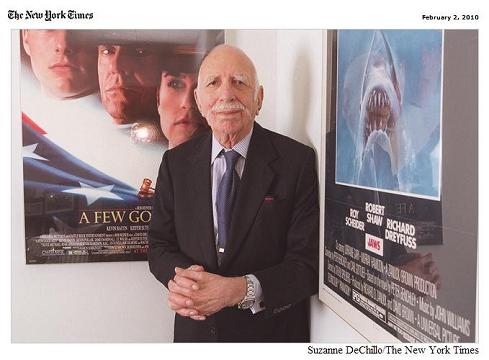
David Brown, producer. Brown died on Monday.
From The Diamond as Big as the Monster in this journal on Dec. 21, 2005–
"At the still point, there the dance is.” –T. S. Eliot, Four Quartets
Eliot was quoted in the epigraph to the chapter on automorphism groups in Parallelisms of Complete Designs, by Peter J. Cameron, published when Cameron was at Merton College, Oxford.
“As Gatsby closed the door of ‘the Merton College Library’ I could have sworn I heard the owl-eyed man break into ghostly laughter.” –F. Scott Fitzgerald
Related material: Yesterday's posts and the jewel in Venn's lotus.
Comments Off on The Great Brown
Thursday, February 4, 2010
From Peter J. Cameron's weblog today—
According to the Buddha,
Scholars speak in sixteen ways of the state of the soul after death. They say that it has form or is formless; has and has not form, or neither has nor has not form; it is finite or infinite; or both or neither; it has one mode of consciousness or several; has limited consciousness or infinite; is happy or miserable; or both or neither.
He does go on to say that such speculation is unprofitable; but bear with me for a moment.
With logical constructs such as “has and has not form, or neither has nor has not form”, it is perhaps a little difficult to see what is going on. But, while I hesitate to disagree with the Compassionate One, I think there are more than sixteen possibilities described here: how many?
Cameron's own answer (from problem solutions for his book Combinatorics)–
One could argue here that the numbers of choices should be multiplied, not added; there are 4 choices for form, 4 for finiteness, 2 for modes of consciousness, 2 for finiteness of consciousness, and 4 for happiness, total 28 = 256. (You may wish to consider whether all 256 are really possible.)
Related material– "What is 256 about?"
Some partial answers–
April 2, 2003 — The Question (lottery number)
May 2, 2003 — Zen and Language Games (page number)
August 4, 2003 — Venn's Trinity (power of two)
September 28, 2005 — Mathematical Narrative (page number)
October 26, 2005 — Human Conflict Number Five (chronomancy)
June 23, 2006 — Binary Geometry (power of two)
July 23, 2006 — Partitions (power of two)
October 3, 2006 — Hard Lessons (number of pages,
as counted in one review)
October 10, 2006 — Mate (lottery number)
October 8, 2008 — Serious Numbers (page number)
Quoted here Nov. 10, 2009—
Epigraphs at
Peter Cameron’s home page:
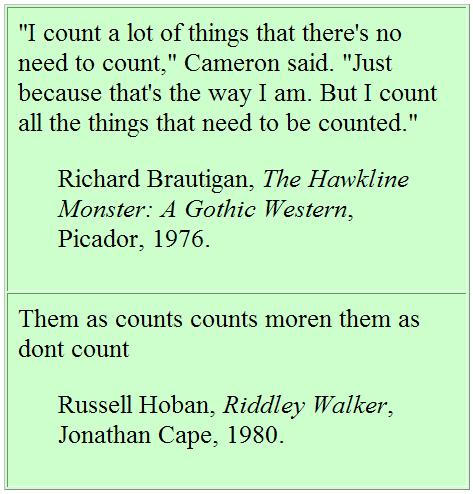
Happy birthday, Russell Hoban.
Comments Off on Phenomenology of 256
Monday, February 1, 2010
From "Time's Breakdown," September 17, 2003—
|
“… even if we can break down time into component Walsh functions, what would it achieve?”
– The Professor, in “Passing in Silence,” by Oliver Humpage
“Being is not a steady state but an occulting one: we are all of us a succession of stillness blurring into motion on the wheel of action, and it is in those spaces of black between the pictures that we find the heart of mystery in which we are never allowed to rest. The flickering of a film interrupts the intolerable continuity of apparent world; subliminally it gives us those in-between spaces of black that we crave.”
– Gösta Kraken, Perception Perceived: an Unfinished Memoir (p. 9 in Fremder, a novel by Russell Hoban)
|
This flashback was suggested by
- A review in next Sunday's New York Times Book Review of a new novel, Point Omega, by Don DeLillo. The review's title (for which the reviewer, Geoff Dyer, should not be blamed) is "A Wrinkle in Time." The review and the book are indeed concerned with time, but the only apparent connection to the 1962 novel of Madeleine L'Engle also titled A Wrinkle in Time is rather indirect– via the Walsh functions mentioned above.
- A phrase in the Times's review, "frame by frame," also appeared in this jounal on Saturday. It formed part of the title of a current exhibition at Harvard's Carpenter Center for the Visual Arts.
- The Carpenter Center exhibition will have an opening reception on February 4.
- February 4 is also the birthday of the above Russell Hoban, who will turn 85. See a British web page devoted to that event.
DeLillo is a major novelist, but the work of Hoban seems more relevant to the phrase "frame by frame."
Comments Off on Frame by Frame
"But wait, there's more!"
– Stanley Fish, NY Times Jan. 28
From the editors at The New York Times who, left to their own devices, would produce yet another generation of leftist morons who don't know the difference between education and entertainment–
A new Times column starts today–

The quality of the column's logo speaks for itself. It pictures a cone with dashed lines indicating height and base radius, but unlabeled except for a large italic x to the right of the cone. This enigmatic variable may indicate the cone's height or slant height– or, possibly, its surface area or volume.
Instead of the column's opening load of crap about numbers and Sesame Street, a discussion of its logo might be helpful.
The cone plays a major role in the historical development of mathematics.
Some background from an online edition of Euclid—
"Euclid proved in proposition XII.10 that the cone with the same base and height as a cylinder was one third of the cylinder, but he could not find the ratio of a sphere to the circumscribed cylinder. In the century after Euclid, Archimedes solved this problem as well as the much more difficult problem of the surface area of a sphere."
For Archimedes and the surface area of a sphere, see (for instance) a discussion by Kevin Brown. For more material on Archimedes, see "Archimedes: Volume of a Sphere," by Doug Faires (2001)– Archimedes' heuristic argument from mechanics that involves the volume of a cone– and Archimedes' more rigorous approach in The Works of Archimedes, edited by T. L. Heath (1897).
The work of Euclid and Archimedes on volumes was, of course, long before the discovery of calculus. For a helpful discussion of cone volumes involving high-school-level calculus, see, for instance, the following–

The Times editors apparently feel that
few of their readers are capable of
such high-school-level sophistication.
For some other geometric illustrations
perhaps more appealing than the Times's

dunce cap, see the symbol of
today's saint– a Bridget Cross—
and a web page on
visualized quaternions.
Comments Off on For St. Bridget’s Day
Saturday, January 30, 2010
"Animation tends to be a condensed art form, using metamorphosis and metaphor to collide and expand meaning. In this way it resembles poetry."
— Harvard's Carpenter Center for the Visual Arts,
description of an exhibition–
FRAME BY FRAME: ANIMATED AT HARVARD
January 28–Feb 14, 2010
For example–
Animation — The Animated Diamond Theorem,
now shown frame by frame for selected frames
Poetry–
Part I — "That Nature is a Heraclitean Fire…."
Part II — Metaphor on the covers of a Salinger book–

Click image for details.
For other thoughts on
metamorphosis and metaphor,
see Endgame.
Comments Off on Metamorphosis and Metaphor
Wednesday, January 27, 2010
Yesterday's post may, if one likes, be regarded
as a nod to Dionysus, god of tragedy.
Here is a complementary passage:

Related material:
Jung and the Imago Dei
Comments Off on To Apollo
Tuesday, January 26, 2010
From this journal:
Transition to the
Garden of Forking Paths–
(See For Baron Samedi)–
The Found Symbol

and Dissemination, by Jacques Derrida,
translated by Barbara Johnson,
London, Athlone Press, 1981–
Pages 354-355
On the mirror-play of the fourfold
Pages 356-357
Shaking up a whole culture
Pages 358-359
Cornerstone and crossroads
Pages 360-361
A deep impression embedded in stone
Pages 362-363
A certain Y, a certain V
Pages 364-365
The world is Zeus's play
Page 366
It was necessary to begin again
Comments Off on Symbology
Sunday, January 24, 2010
More Than Matter
| Wheel in Webster’s Revised Unabridged Dictionary, 1913
(f) Poetry
The burden or refrain of a song.
⇒ “This meaning has a low degree of authority, but is supposed from the context in the few cases where the word is found.” Nares.
You must sing a-down a-down, An you call him a-down-a. O, how the wheel becomes it! Shak.
|
“In one or other of G. F. H. Shadbold’s two published notebooks, Beyond Narcissus and Reticences of Thersites, a short entry appears as to the likelihood of Ophelia’s enigmatic cry: ‘Oh, how the wheel becomes it!’ referring to the chorus or burden ‘a-down, a-down’ in the ballad quoted by her a moment before, the aptness she sees in the refrain.”
— First words of Anthony Powell’s novel “O, How the Wheel Becomes It!” (See Library Thing.)

Related material:
Photo uploaded on January 14, 2009
with caption “This nothing’s more than matter”
and the following nothings from this journal
on the same date– Jan. 14, 2009—

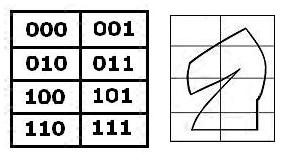


Comments Off on Today’s Sermon
Saturday, January 9, 2010
"The positional meaning of a symbol derives from its relationship to other symbols in a totality, a Gestalt, whose elements acquire their significance from the system as a whole."
— Victor Turner, The Forest of Symbols, Ithaca, NY, Cornell University Press, 1967, p. 51, quoted by Beth Barrie in "Victor Turner."
To everything, turn, turn, turn…
— Peter Seeger
The Galois Quaternion:

Click for context.
Comments Off on Positional Meaning
Wednesday, January 6, 2010
The Galois Quaternion
|
I had foreseen it all in precise detail.
One step led inevitably to the next,
like the proof of a shining theorem,
down to the conclusive shot that still echoes
through time and space.
Facedown in the damp pine needles,
I embraced that fatal sphere
with my whole body. Dreams, memories,
even the mathematics I had cherished
and set down in my last will and testament–
all receded. I am reduced to
a singular point; in an instant
I am transformed to i.
i = an imaginary being
Here, on this complex space,
i am no longer the impetuous youth
who wanted to change the world
first with a formula and then with a flame.
Having learned the meaning of infinite patience,
i now rise to the text whenever anyone reads
about Evariste Galois, preferring to remain
just below the surface,
like a goldfish nibbling the fringe of a floating leaf.
Ink is more mythical than blood
(unless some ancient poet slit his
vein and wrote an epic in red):
The text is a two-way mirror
that allows me to look into
the life and times of the reader.
Who knows, someday i may rise
to a text that will compel me
to push through to the other side.
Do you want proof that i exist? Where am i?
Beneath every word, behind each letter,
on the side of a period that will never see the light.
|
Related material:
The Galois Quaternion

Click for context.
(See also Nativity and the end
of this morning's post.)
Comments Off on Brightness at Noon, continued
|
January 06, 2007
ART WARS: Epiphany
Picture of Nothing
“Varnedoe’s lectures were ultimately about faith, about his faith in the power of abstraction, and abstraction as a kind of anti-religious faith in itself….”
Related material:
The more industrious scholars will derive considerable pleasure from describing how the art-history professors and journalists of the period 1945-75, along with so many students, intellectuals, and art tourists of every sort, actually struggled to see the paintings directly, in the old pre-World War II way, like Plato’s cave dwellers watching the shadows, without knowing what had projected them, which was the Word.”
— Tom Wolfe, The Painted Word
Log24, Aug. 23, 2005:
“Concept (scholastics’ verbum mentis)– theological analogy of Son’s procession as Verbum Patris, 111-12″ — Index to Joyce and Aquinas, by William T. Noon, S.J., Yale University Press 1957, second printing 1963, page 162
“So did God cause the big bang? Overcome by metaphysical lassitude, I finally reach over to my bookshelf for The Devil’s Bible. Turning to Genesis I read: ‘In the beginning there was nothing. And God said, ‘Let there be light!’ And there was still nothing, but now you could see it.'”
— Jim Holt, Big-Bang Theology, from Slate‘s “High Concept” department

“Bang.”
“…Mondrian and Malevich are not discussing canvas or pigment or graphite or any other form of matter. They are talking about Being or Mind or Spirit. From their point of view, the grid is a staircase to the Universal….”
|
Some Context:

Click to enlarge.
See also Nativity.
Comments Off on Epiphany Revisited
Wednesday, December 30, 2009

Arthur Koestler by David Levine,
New York Review of Books,
December 17, 1964
A Jesuit at the
Gerard Manley Hopkins Archive:
‘Bisociation’: The Act of Creation
Koestler’s concept of ‘bisociation’… enters into the very ‘act of creation.’ In every such act, writes Koestler, the creator ‘bisociates,’ that is, combines, two ‘matrices’– two diverse patterns of knowing or perceiving– in a new way. As each matrix carries its own images, concepts, values, and ‘codes,’ the creative person brings together– ‘bisociates’– two diverse matrices not normally connected.
— Joseph J. Feeney, S.J.
|
See also December 9, 2009:
The theme of the January 2010 issue of the
Notices of the American Mathematical Society
is “Mathematics and the Arts.”
Related material:
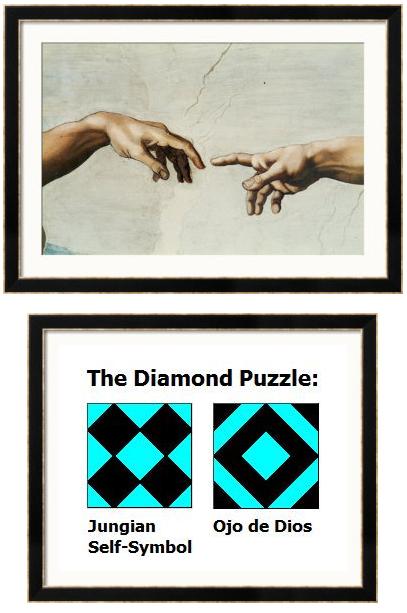
Comments Off on Fearful Symmetry
Sunday, December 20, 2009
Dies Natalis of
Emil Artin
From the September 1953 Bulletin of the American Mathematical Society—
Emil Artin, in a review of Éléments de mathématique, by N. Bourbaki, Book II, Algebra, Chaps. I-VII–
"We all believe that mathematics is an art. The author of a book, the lecturer in a classroom tries to convey the structural beauty of mathematics to his readers, to his listeners. In this attempt he must always fail. Mathematics is logical to be sure; each conclusion is drawn from previously derived statements. Yet the whole of it, the real piece of art, is not linear; worse than that its perception should be instantaneous. We all have experienced on some rare occasions the feeling of elation in realizing that we have enabled our listeners to see at a moment's glance the whole architecture and all its ramifications. How can this be achieved? Clinging stubbornly to the logical sequence inhibits the visualization of the whole, and yet this logical structure must predominate or chaos would result."
Art Versus Chaos

From an exhibit,
"Reimagining Space"
The above tesseract (4-D hypercube)
sculpted in 1967 by Peter Forakis
provides an example of what Artin
called "the visualization of the whole."
For related mathematical details see
Diamond Theory in 1937.
"'The test?' I faltered, staring at the thing.
'Yes, to determine whether you can live
in the fourth dimension or only die in it.'"
— Fritz Leiber, 1959
See also the Log24 entry for
Nov. 26, 2009, the date that
Forakis died.
"There is such a thing
as a tesseract."
— Madeleine L'Engle, 1962
Comments Off on The Test
Saturday, December 12, 2009
Today's previous entry quoted a review by Edward Rothstein of Jung's The Red Book. The entry you are now reading quotes a review by Jim Holt of a notable book by Rothstein:
The Golden Book—

Cover illustration— Arithmetic and Music,
Borgia Apartments, The Vatican
Jim Holt reviewing Edward Rothstein's Emblems of Mind: The Inner Life of Music and Mathematics in The New Yorker of June 5, 1995:
Advent
"The fugues of Bach, the symphonies of Haydn, the sonatas of Mozart: these were explorations of ideal form, unprofaned by extramusical associations. Such 'absolute music,' as it came to be called, had sloughed off its motley cultural trappings. It had got in touch with its essence. Which is why, as Walter Pater famously put it, 'all art constantly aspires towards the condition of music.'
The only art that can rival music for sheer etheriality is mathematics. A century or so after the advent of absolute music, mathematics also succeeded in detaching itself from the world. The decisive event was the invention of strange, non-Euclidean geometries, which put paid to the notion that the mathematician was exclusively, or even primarily, concerned with the scientific universe. 'Pure' mathematics came to be seen by those who practiced it as a free invention of the imagination, gloriously indifferent to practical affairs– a quest for beauty as well as truth."
Related material: Hardy's Apology, Non-Euclidean Blocks, and The Story Theory of Truth.
See also Holt on music and emotion:

"Music does model… our emotional life… although
the methods by which it does so are 'puzzling.'"
Also puzzling: 2010 AMS Notices.
Comments Off on For Sinatra’s Birthday
Wednesday, December 9, 2009
The theme of the January 2010 issue of the
Notices of the American Mathematical Society
is "Mathematics and the Arts."
Related material:

The Diamond Puzzle
may be downloaded by
viewing it in Internet Explorer
and saving it in the
"web archive" (*.mht) format.
Saturday, December 5, 2009
Time and Chance, continued…
NY Lottery numbers today–
Midday 401, Evening 717
_________________________________________________
From this journal on 4/01, 2009:
The Cruelest Month
"Langdon sensed she was
toying with him…."
— Dan Brown
___________________________________________
From this journal on 7/17, 2008:
Jung’s four-diamond figure from
Aion — a symbol of the self –

Jung’s Map of the Soul,
by Murray Stein:
“… Jung thinks of the self as undergoing continual transformation during the course of a lifetime…. At the end of his late work Aion, Jung presents a diagram to illustrate the dynamic movements of the self….”
For related dynamic movements,
see the Diamond 16 Puzzle
and the diamond theorem.
______________________________________________
A piece related to both of the above posts–
"The Symbologist," a review, respectful despite the editor's sarcastic title, of Jung's Red Book in the December 6th New York Times Book Review.
Comments Off on Holiday Book
Friday, December 4, 2009
From Peter J. Cameron's
Parallelisms of Complete Designs (pdf)–
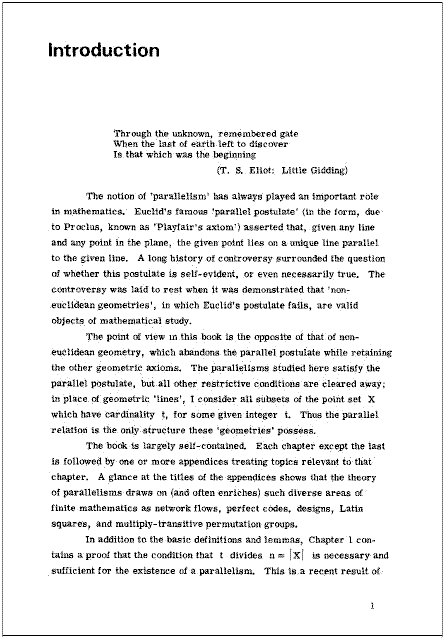
"…the Feast of Nicholas Ferrar
is kept on the 4th December."
— Little Gidding Church
Cameron's is the usual definition
of the term "non-Euclidean."
I prefer a more logical definition.
Comments Off on Parallelism
Sunday, November 15, 2009
Part I: The Search
Part II: The Rock
Related metaphors–
Three Tales
Related illustration–
The Dome of the Rock:

Comments Off on A Sermon for Hogwarts
Saturday, November 14, 2009
A graphic novel reviewed in the current Washington Post features Alfred North Whitehead and Bertrand Russell–

Related material:
Whitehead on Fano’s finite projective three-space:
“This is proved by the consideration of a three dimensional geometry in which there are only fifteen points.”
—The Axioms of Projective Geometry , Cambridge University Press, 1906
A related affine six-space:

Further reading:
See Solomon’s Cube and the link at the end of today’s previous entry, then compare and contrast the above portraits of Whitehead and Russell with Charles Williams’s portraits of Sir Giles Tumulty and Lord Arglay in the novel Many Dimensions .
“It was a dark and stormy night….“
Comments Off on Mathematics and Narrative, continued:
Sunday, November 8, 2009
A Sequel to Koestler's
The Call Girls
Gilles Deleuze, Negotiations 1972-1990,
Columbia University Press paperback, 1997, p. 137–
"Academics' lives are seldom interesting."
But then there is Matt Lee of the University of Greenwich.
See his weblog subtitled "notes and thoughts on philosophy"… particularly his post "Diamond time, daimon time," of August 20, 2009.
See also my own post of August 20, 2009– "Sophists"– and my earlier post "Daimon Theory" of March 12, 2003:
More about Lee:
"Chaos majik is a form of modern witchcraft."
More about magick:
Noetic Symbology
(Log24 on October 25, 2009)
Some Related Log24 Posts
Comments Off on H is for Hogwarts, continued
Wednesday, November 4, 2009
As noted here yesterday, Claude Levi-Strauss may have died on Devil's Night, on Halloween, or on All Saints' Day. He was apparently a myth-transformer to the end.
The Independent says today he died on Sunday, All Saints' Day. Its eulogy, by Adam Kuper, is well-written, noting that linguist Roman Jakobson was a source of Levi-Strauss's theory of oppositions in myth, and observing that
"… binary oppositions tend to accumulate to form structures…."
Yes, they do. Examples:
I. The structures in the Diamond Puzzle…

Click on image for Jungian background.
II: The structure on a recent cover of Semiotica…

Click to enlarge.
The Semiotica article by mathematical linguist Solomon Marcus is a defense of the Levi-Strauss canonic formula mentioned here yesterday.
It is available online for $40.
A less expensive, and possibly more informative, look at oppositions in linguistics is available for free online in a 1984 master's thesis (pdf, 8+ mb)–
"Language, Linguistics, and Philosophy: A Comparison of the Work of Roman Jakobson and the Later Wittgenstein, with Some Attention to the Philosophy of Charles Saunders Peirce," by Miles Spencer Kimball.
Comments Off on Sinner or Saint?
Sunday, November 1, 2009
Suggested by the New York State lottery numbers on All Hallows' Eve–
430 (mid-day) and 168 (evening)…
From 430 as a date, 4/30— Beyond Grief and Nothing: A Reading of Don DeLillo, by Joseph Dewey, University of South Carolina Press, 2006, page 123:
"It is as if DeLillo himself had moved to an endgame…."
For such an endgame, see yesterday's link to a Mira Sorvino drama. The number 168 suggested by the Halloween lottery deals with the properties of space itself and requires a more detailed exegesis… For the full picture, consider the Log24 entries of Feb. 16-28 this year, esp. the entries of Feb. 27 and the phrase they suggest–
Flores, Flores para los muertos.
Consider also Xinhua today, with its discussion of rocket science and seal-cutting:

Click image for context.
For space technology, see the above link to Feb. 16-28 this year as well as the following (click on image for details)–

As for seal-cutting, see the following seal from a Korean Christian site:

See Mizian Translation Service for some background on the seal's designer.
Comments Off on October Endgame
Saturday, October 24, 2009
A search for “Chinese Cube” (based on the the previous entry’s title) reveals the existence of a most interesting character, who…
“… has attempted in his books to produce a Science and Art of Reasoning using the simplest of the Platonic solids, the Cube. [His] model also parallels, in some ways, the Cube of Space constructed from the Sepher Yetzirah’s attributions for the Hebrew letters and their direction. [He] elucidated his theories at great length….”
— More…
For related remarks, see the link to Solomon’s Cube from the previous entry.
Then of course there is…

Click on figure for details.
Comments Off on Chinese Cubes Continued
Monday, October 19, 2009
Modernity: A Film by
Alfred Hitchcock:
“… the most thoroughgoing modernist design element in Hitchcock’s films arises out of geometry, as Francois Regnault has argued, identifying ‘a global movement for each one, or a “principal geometric or dynamic form,” which can appear in the pure state in the credits….'” –Peter J. Hutchings (my italics)
John Lithgow
is 64 today.
Happy birthday.
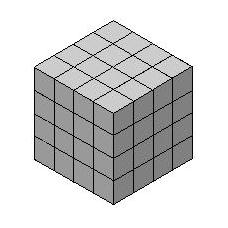
Comments Off on Hitchcock for Lithgow
Wednesday, October 14, 2009
Singer 7-Cycles


Click on images for details.
The 1985 Cullinane version gives some algebraic background for the 1987 Curtis version.
Comments Off on Wednesday October 14, 2009
Sunday, October 11, 2009
Comments Off on Sunday October 11, 2009
Monday, October 5, 2009
— Sondheim in translation
Comments Off on Monday October 5, 2009
Friday, October 2, 2009
| Edge on Heptads
Part I: Dye on Edge
“Summary:
….we obtain various orbits of partitions of quadrics over GF(2a) by their maximal totally singular subspaces; the corresponding stabilizers in the relevant orthogonal groups are investigated. It is explained how some of these partitions naturally generalize Conwell’s heptagons for the Klein quadric in PG(5,2).”
“Introduction:
In 1910 Conwell… produced his heptagons in PG(5,2) associated with the Klein quadric K whose points represent the lines of PG(3,2)…. Edge… constructed the 8 heptads of complexes in PG(3,2) directly. Both he and Conwell used their 8 objects to establish geometrically the isomorphisms SL(4,2)=A8 and O6(2)=S8 where O6(2) is the group of K….”
— “Partitions and Their Stabilizers for Line Complexes and Quadrics,” by R.H. Dye, Annali di Matematica Pura ed Applicata, Volume 114, Number 1, December 1977, pp. 173-194
Part II: Edge on Heptads
“The Geometry of the Linear Fractional Group LF(4,2),” by W.L. Edge, Proc. London Math Soc., Volume s3-4, No. 1, 1954, pp. 317-342. See the historical remarks on the first page.
Note added by Edge in proof:
“Since this paper was finished I have found one by G. M. Conwell: Annals of Mathematics (2) 11 (1910), 60-76….” |
Some context:
Comments Off on Friday October 2, 2009
Wednesday, September 30, 2009
Midnight in the Garden, Autumn 2009
Sunday, September 27, 2009
A Pleasantly
Discursive Treatment
In memory of Unitarian
minister
Forrest Church,
dead at 61 on Thursday:

Unitarian Universalist Origins: Our Historic Faith—
“In sixteenth-century Transylvania, Unitarian congregations were established for the first time in history.”
Gravity’s Rainbow–
“For every kind of vampire, there is a kind of cross.”
Unitarian minister Richard Trudeau—
“… I called the belief that
(1) Diamonds– informative, certain truths about the world– exist
the ‘Diamond Theory’ of truth. I said that for 2200 years the strongest evidence for the Diamond Theory was the widespread perception that
(2) The theorems of Euclidean geometry are diamonds….
As the news about non-Euclidean geometry spread– first among mathematicians, then among scientists and philosophers– the Diamond Theory began a long decline that continues today.
Factors outside mathematics have contributed to this decline. Euclidean geometry had never been the Diamond Theory’s only ally. In the eighteenth century other fields had seemed to possess diamonds, too; when many of these turned out to be man-made, the Diamond Theory was undercut. And unlike earlier periods in history, when intellectual shocks came only occasionally, received truths have, since the eighteenth century, been found wanting at a dizzying rate, creating an impression that perhaps no knowledge is stable.
Other factors notwithstanding, non-Euclidean geometry remains, I think, for those who have heard of it, the single most powerful argument against the Diamond Theory*– first, because it overthrows what had always been the strongest argument in favor of the Diamond Theory, the objective truth of Euclidean geometry; and second, because it does so not by showing Euclidean geometry to be false, but by showing it to be merely uncertain.” —The Non-Euclidean Revolution, p. 255
H. S. M. Coxeter, 1987, introduction to Trudeau’s book—
As noted here on Oct. 8, 2008 (A Yom Kippur Meditation), Coxeter was aware in 1987 of a more technical use of the phrase “diamond theory” that is closely related to…
A kind
of cross:
Mirror-Play
of the Fourfold.
* As
recent Log24 entries have pointed out, diamond theory (in the original
1976 sense)
is a type of non-Euclidean geometry, since
finite geometry is not Euclidean geometry– and is, therefore,
non-Euclidean, in the strictest sense (though not according to popular usage).
Comments Off on Sunday September 27, 2009
Sunday, September 20, 2009
Comments Off on Sunday September 20, 2009
Saturday, September 19, 2009
Old Year, Raus!
Also in today’s New York Times obituaries index:
John T. Elson, Editor Who Asked
“Is God Dead?” at Time, Dies at 78

Wikipedia article on George Polya:
- Look for a pattern
- Draw a picture
- Solve a simpler problem
- Use a model
- Work backward
From the date of Elson’s death:
Comments Off on Saturday September 19, 2009
Thursday, September 17, 2009
Jennifer's Body
The following remark this evening by Ann Hornaday of The Washington Post serves as an instant review of today's previous cinematic Log24 offering starring the late Patrick Swayze:
"Watch it, forget it, move on."
A perhaps more enduring tribute:
Comments Off on Thursday September 17, 2009
Monday, September 14, 2009
Figure

The Sept. 8 entry on non-Euclidean* blocks ended with the phrase “Go figure.” This suggested a MAGMA calculation that demonstrates how Klein’s simple group of order 168 (cf. Jeremy Gray in The Eightfold Way) can be visualized as generated by reflections in a finite geometry.
* i.e., other than Euclidean. The phrase “non-Euclidean” is usually applied to only some of the geometries that are not Euclidean. The geometry illustrated by the blocks in question is not Euclidean, but is also, in the jargon used by most mathematicians, not “non-Euclidean.”
Comments Off on Monday September 14, 2009
Tuesday, September 8, 2009
Froebel's
Magic Box

Continued from
Dec. 7, 2008,
and from
yesterday.
Non-Euclidean
Blocks
Passages from a classic story:
… he took from his pocket a gadget he had found in the box, and began to unfold it. The result resembled a tesseract, strung with beads….
 Tesseract
Tesseract
"Your mind has been conditioned to Euclid," Holloway said. "So this– thing– bores us, and seems pointless. But a child knows nothing of Euclid. A different sort of geometry from ours wouldn't impress him as being illogical. He believes what he sees."
"Are you trying to tell me that this gadget's got a fourth dimensional extension?" Paradine demanded.
"Not visually, anyway," Holloway denied. "All I say is that our minds, conditioned to Euclid, can see nothing in this but an illogical tangle of wires. But a child– especially a baby– might see more. Not at first. It'd be a puzzle, of course. Only a child wouldn't be handicapped by too many preconceived ideas."
"Hardening of the thought-arteries," Jane interjected.
Paradine was not convinced. "Then a baby could work calculus better than Einstein? No, I don't mean that. I can see your point, more or less clearly. Only–"
"Well, look. Let's suppose there are two kinds of geometry– we'll limit it, for the sake of the example. Our kind, Euclidean, and another, which we'll call x. X hasn't much relationship to Euclid. It's based on different theorems. Two and two needn't equal four in it; they could equal y, or they might not even equal. A baby's mind is not yet conditioned, except by certain questionable factors of heredity and environment. Start the infant on Euclid–"
"Poor kid," Jane said.
Holloway shot her a quick glance. "The basis of Euclid. Alphabet blocks. Math, geometry, algebra– they come much later. We're familiar with that development. On the other hand, start the baby with the basic principles of our x logic–"
"Blocks? What kind?"
Holloway looked at the abacus. "It wouldn't make much sense to us. But we've been conditioned to Euclid."
— "Mimsy Were the Borogoves," Lewis Padgett, 1943
|
Padgett (pseudonym of a
husband-and-
wife writing team) says that alphabet blocks are the intuitive "basis of Euclid."
Au contraire; they are the basis of
Gutenberg.
For the intuitive basis of one type of non-Euclidean* geometry– finite geometry over the two-element Galois field– see the work of…
Friedrich Froebel
(1782-1852), who
invented kindergarten.
His "third gift" —

 © 2005 The Institute for Figuring
© 2005 The Institute for Figuring
Comments Off on Tuesday September 8, 2009
Monday, September 7, 2009
Magic Boxes
"Somehow it seems to fill my head with ideas– only I don't exactly know what they are!…. Let's have a look at the garden first!"
— A passage from Lewis Carroll's Through the Looking-Glass. The "garden" part– but not the "ideas" part– was quoted by Jacques Derrida in Dissemination in the epigraph to Chapter 7, "The Time before First."
Commentary
on the passage:
Part I "The Magic Box," shown on Turner Classic Movies earlier tonight
Part II: "Mimsy Were the Borogoves," a classic science fiction story:
"… he lifted a square, transparent crystal block, small enough to cup in his palm– much too small to contain the maze of apparatus within it. In a moment Scott had solved that problem. The crystal was a sort of magnifying glass, vastly enlarging the things inside the block. Strange things they were, too. Miniature people, for example– They moved. Like clockwork automatons, though much more smoothly. It was rather like watching a play."
Part III: A Crystal Block —
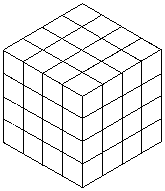

Image of pencils is by
Diane Robertson Design.
Related material:
"A Four-Color Theorem."
Part IV:

"Click on the Yellow Book."
Comments Off on Monday September 7, 2009
Sunday, September 6, 2009
Magic Boxes
Part I: “The Magic Box,” shown on Turner Classic Movies tonight
Part II: “Mimsy Were the Borogoves,” a classic science fiction story:
“… he lifted a square, transparent crystal block, small enough to cup in his palm– much too small to contain the maze of apparatus within it. In a moment Scott had solved that problem. The crystal was a sort of magnifying glass, vastly enlarging the things inside the block. Strange things they were, too. Miniature people, for example–
They moved. Like clockwork automatons, though much more smoothly. It was rather like watching a play.”
Comments Off on Sunday September 6, 2009
Saturday, September 5, 2009
Comments Off on Saturday September 5, 2009
Thursday, September 3, 2009
Autistic Enchantment
“Music and mathematics are among the pre-eminent wonders of the race. Levi-Strauss sees in the invention of melody ‘a key to the supreme mystery’ of man– a clue, could we but follow it, to the singular structure and genius of the species. The power of mathematics to devise actions for reasons as subtle, witty, manifold as any offered by sensory experience and to move forward in an endless unfolding of self-creating life is one of the strange, deep marks man leaves on the world. Chess, on the other hand, is a game in which thirty-two bits of ivory, horn, wood, metal, or (in stalags) sawdust stuck together with shoe polish, are pushed around on sixty-four alternately coloured squares. To the addict, such a description is blasphemy. The origins of chess are shrouded in mists of controversy, but unquestionably this very ancient, trivial pastime has seemed to many exceptionally intelligent human beings of many races and centuries to constitute a reality, a focus for the emotions, as substantial as, often more substantial than, reality itself. Cards can come to mean the same absolute. But their magnetism is impure. A mania for whist or poker hooks into the obvious, universal magic of money. The financial element in chess, where it exists at all, has always been small or accidental.
To a true chess player, the pushing about of thirty-two counters on 8×8 squares is an end in itself, a whole world next to which that of a mere biological or political or social life seems messy, stale, and contingent. Even the patzer, the wretched amateur who charges out with his knight pawn when the opponent’s bishop decamps to R4, feels this daemonic spell. There are siren moments when quite normal creatures otherwise engaged, men such as Lenin and myself, feel like giving up everything– marriage, mortgages, careers, the Russian Revolution– in order to spend their days and nights moving little carved objects up and down a quadrate board. At the sight of a set, even the tawdriest of plastic pocket sets, one’s fingers arch and a coldness as in a light sleep steals over one’s spine. Not for gain, not for knowledge or reknown, but in some autistic enchantment, pure as one of Bach’s inverted canons or Euler’s formula for polyhedra.”
— George Steiner in “A Death of Kings,” The New Yorker, issue dated September 7, 1968, page 133
“Examples are the stained-glass windows of knowledge.” —
Nabokov

Click above images for some context.
Comments Off on Thursday September 3, 2009
Monday, August 31, 2009
Ask a Stupid Question
continued from
last Wednesday…
Log24 on August 26–
"Did you see more glass?"
|
Wednesday, August 26,
was the date of death
for Hyman Bloom.
Bloom often painted portraits of imaginary rabbis; an article titled "American Mystic" describes
"… the mesmerizing paradox at the heart of the rabbi portraits– they remember keepers of a tradition in a method that tradition expressly forbids. As Bloom explains, age and illness endowing his voice with a hoarse, prophetic quality, 'Jewish culture has nothing to do with painting. That’s a rule, "Thou shalt not make an image of anything in the air or on the earth."'"
Related material:
An entry in this journal linked to twice on the date of Bloom's death–
Art and Man at Yale–
and an illustrated entry from this journal on the date of the "Mystic" article–
Elements of Geometry.
"So, there is one place
where modernism triumphs.
As in the cases of the pyramids
and the Taj Mahal, the Siegfried line
and the Atlantic wall, death always
calls on the very best architects."
– J. G. Ballard,
"
A Handful of Dust"
Comments Off on Monday August 31, 2009
Thursday, August 20, 2009
Sophists
From David Lavery’s weblog today—
Kierkegaard on Sophists:
“If the natural sciences had been developed in Socrates’ day as they are now, all the sophists would have been scientists. One would have hung a microscope outside his shop in order to attract customers, and then would have had a sign painted saying: Learn and see through a giant microscope how a man thinks (and on reading the advertisement Socrates would have said: that is how men who do not think behave).”
— Søren Kierkegaard, Journals, edited and translated by Alexander Dru
To anyone familiar with Pirsig’s classic Zen and the Art of Motorcycle Maintenance, the above remarks of Kierkegaard ring false. Actually, the sophists as described by Pirsig are not at all like scientists, but rather like relativist purveyors of postmodern literary “theory.” According to Pirsig, the scientists are like Plato (and hence Socrates)– defenders of objective truth.
Pirsig on Sophists:
“The pre-Socratic philosophers mentioned so far all sought to establish a universal Immortal Principle in the external world they found around them. Their common effort united them into a group that may be called Cosmologists. They all agreed that such a principle existed but their disagreements as to what it was seemed irresolvable. The followers of Heraclitus insisted the Immortal Principle was change and motion. But Parmenides’ disciple, Zeno, proved through a series of paradoxes that any perception of motion and change is illusory. Reality had to be motionless.
The resolution of the arguments of the Cosmologists came from a new direction entirely, from a group Phædrus seemed to feel were early humanists. They were teachers, but what they sought to teach was not principles, but beliefs of men. Their object was not any single absolute truth, but the improvement of men. All principles, all truths, are relative, they said. ‘Man is the measure of all things.’ These were the famous teachers of ‘wisdom,’ the Sophists of ancient Greece.
To Phaedrus, this backlight from the conflict between the Sophists and the Cosmologists adds an entirely new dimension to the Dialogues of Plato. Socrates is not just expounding noble ideas in a vacuum. He is in the middle of a war between those who think truth is absolute and those who think truth is relative. He is fighting that war with everything he has. The Sophists are the enemy.
Now Plato’s hatred of the Sophists makes sense. He and Socrates are defending the Immortal Principle of the Cosmologists against what they consider to be the decadence of the Sophists. Truth. Knowledge. That which is independent of what anyone thinks about it. The ideal that Socrates died for. The ideal that Greece alone possesses for the first time in the history of the world. It is still a very fragile thing. It can disappear completely. Plato abhors and damns the Sophists without restraint, not because they are low and immoral people… there are obviously much lower and more immoral people in Greece he completely ignores. He damns them because they threaten mankind’s first beginning grasp of the idea of truth. That’s what it is all about.
The results of Socrates’ martyrdom and Plato’s unexcelled prose that followed are nothing less than the whole world of Western man as we know it. If the idea of truth had been allowed to perish unrediscovered by the Renaissance it’s unlikely that we would be much beyond the level of prehistoric man today. The ideas of science and technology and other systematically organized efforts of man are dead-centered on it. It is the nucleus of it all.
And yet, Phaedrus understands, what he is saying about Quality is somehow opposed to all this. It seems to agree much more closely with the Sophists.”
I agree with Plato’s (and Rebecca Goldstein’s) contempt for relativists. Yet Pirsig makes a very important point. It is not the scientists but rather the storytellers (not, mind you, the literary theorists) who sometimes seem to embody Quality.
As for hanging a sign outside the shop, I suggest (particularly to New Zealand’s Cullinane College) that either or both of the following pictures would be more suggestive of Quality than a microscope:
Comments Off on Thursday August 20, 2009
Wednesday, August 19, 2009
Comments Off on Wednesday August 19, 2009
Group Actions, 1984-2009
From a 1984 book review:
"After three decades of intensive research by hundreds of group theorists, the century old problem of the classification of the finite simple groups has been solved and the whole field has been drastically changed. A few years ago the one focus of attention was the program for the classification; now there are many active areas including the study of the connections between groups and geometries, sporadic groups and, especially, the representation theory. A spate of books on finite groups, of different breadths and on a variety of topics, has appeared, and it is a good time for this to happen. Moreover, the classification means that the view of the subject is quite different; even the most elementary treatment of groups should be modified, as we now know that all finite groups are made up of groups which, for the most part, are imitations of Lie groups using finite fields instead of the reals and complexes. The typical example of a finite group is GL(n, q), the general linear group of n dimensions over the field with q elements. The student who is introduced to the subject with other examples is being completely misled."
— Jonathan L. Alperin,
review of books on group theory,
Bulletin (New Series) of the American
Mathematical Society 10 (1984) 121, doi:
10.1090/S0273-0979-1984-15210-8

The same example
at Wolfram.com:

Caption from Wolfram.com:
"The two-dimensional space Z3×Z3 contains nine points: (0,0), (0,1), (0,2), (1,0), (1,1), (1,2), (2,0), (2,1), and (2,2). The 48 invertible 2×2 matrices over Z3 form the general linear group known as GL(2, 3). They act on Z3×Z3 by matrix multiplication modulo 3, permuting the nine points. More generally, GL(n, p) is the set of invertible n×n matrices over the field Zp, where p is prime. With (0, 0) shifted to the center, the matrix actions on the nine points make symmetrical patterns."
Citation data from Wolfram.com:
"GL(2,p) and GL(3,3) Acting on Points"
from The Wolfram Demonstrations Project,
http://demonstrations.wolfram.com/GL2PAndGL33ActingOnPoints/,
Contributed by: Ed Pegg Jr"
As well as displaying Cullinane's 48 pictures of group actions from 1985, the Pegg program displays many, many more actions of small finite general linear groups over finite fields. It illustrates Cullinane's 1985 statement:
"Actions of GL(2,p) on a p×p coordinate-array have the same sorts of symmetries, where p is any odd prime."
Pegg's program also illustrates actions on a cubical array– a 3×3×3 array acted on by GL(3,3). For some other actions on cubical arrays, see Cullinane's Finite Geometry of the Square and Cube.
Comments Off on Wednesday August 19, 2009
Monday, August 17, 2009
“… Kirkman has established an incontestable claim to be regarded as the founding father of the theory of designs.”
— “T.P. Kirkman, Mathematician,” by N.L. Biggs, Bulletin of the London Mathematical Society, Volume 13, Number 2 (March 1981), 97-120.
This paper is now available online for $12.
For more about this subject, see Design Theory, by Beth, Jungnickel, and Lenz, Cambridge U. Press, Volume I (2nd ed., 1999, 1120 pages) and Volume II (2nd ed., 2000, 513 pages).
For an apparently unrelated subject with the same name, see Graphic Design Theory: Readings from the Field, by Helen Armstrong (Princeton Architectural Press, 2009).
For what the two subjects have in common, see Block Designs in Art and Mathematics.
Comments Off on Monday August 17, 2009
Saturday, August 15, 2009
For St. Willard
Van Orman Quine
" ... to apprehend
The point of intersection of the timeless
With time, is an occupation for the saint"
-- Four Quartets

Quine receives
Kyoto Prize
The Timeless:

Time
(64 years,
and more):
| Today in History
By The Associated Press (AP)
Today is Saturday, Aug. 15, the 227th day of 2009. There are 138 days left in the year.
Today’s Highlight in History:
On Aug. 15, 1945, Japanese Emperor Hirohito announced to his subjects in a prerecorded radio address that Japan had accepted terms of surrender for ending World War II.
On this date:
In 1057, Macbeth, King of Scots, was killed in battle by Malcolm, the eldest son of King Duncan, whom Macbeth had slain.
|
Macbeth:
"Life's but a walking shadow, a poor player
That struts and frets his hour upon the stage
And then is heard no more: it is a tale
Told by an idiot, full of sound and fury,
Signifying nothing."
Quine:
“I really have nothing to add.”
— Quine, quoted
on this date in 1998.
Comments Off on Saturday August 15, 2009
Wednesday, August 12, 2009
Exegesis
Text:
The Shining,
1977, page 162:
“A new headline, this one
dated April 10….”
“The item on the next page
was a mere squib, dated
four months later….”
|
Exegesis:
Comments Off on Wednesday August 12, 2009
Thursday, August 6, 2009
A Fisher of Men
 Update: The above image was added
Update: The above image was added
at about 11 AM ET Aug. 8, 2009.

From a webpage of the First United Methodist Church of Bloomington, Indiana–
Dr. Joe Emerson, April 24, 2005–
"The Ultimate Test"
— Text: I Peter 2:1-9
Dr. Emerson falsely claims that the film "On the Waterfront" was based on a book by the late Budd Schulberg (who died yesterday). (Instead, the film's screenplay, written by Schulberg– similar to an earlier screenplay by Arthur Miller, "The Hook"– was based on a series of newspaper articles by Malcolm Johnson.)
"The movie 'On the Waterfront' is once more in rerun. (That’s when Marlon Brando looked like Marlon Brando. That’s the scary part of growing old when you see what he looked like then and when he grew old.) It is based on a book by Budd Schulberg."
Emerson goes on to discuss the book, Waterfront, that Schulberg wrote based on his screenplay–
"In it, you may remember a scene where Runty Nolan, a little guy, runs afoul of the mob and is brutally killed and tossed into the North River. A priest is called to give last rites after they drag him out."

New York Times today
Comments Off on Thursday August 6, 2009
Tuesday, August 4, 2009
Comments Off on Tuesday August 4, 2009
Comments Off on Tuesday August 4, 2009
Saturday, August 1, 2009
And the Tony
goes to…
The New York Times today:
"Tony Rosenthal, who created 'Alamo,' the eternally popular revolving black cube in Astor Place in the East Village, and many other public sculptures, died on Tuesday [July 28, 2009] in Southampton, N.Y. He was 94."
The Astor Place sculpture, near Cooper Union, is also known as The Borg Cube:
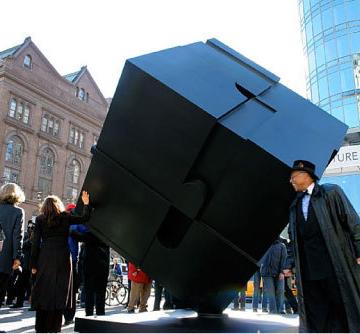
The Borg Cube, with
Cooper Union at left
Wikipedia on The Borg Queen:
"The Borg Queen is the focal point within the Borg collective consciousness."
Possible Borg-Queen candidates:
Helen Mirren, who appeared in this journal on the date of Rosenthal's death (see Monumental Anniversary), and Julie Taymor, who recently directed Mirren as Prospera in a feminist version of "The Tempest."
Both Mirren and Taymor would appreciate the work of Anita Borg, who pioneered the role of women in computer science. "Her colleagues mourned Borg's passing, even as they stressed how crucial she was in creating a kind of collective consciousness for women working in the heavily male-dominated field of computer technology." —Salon.com obituary

Anita Borg
Borg died on Sunday, April 6, 2003. See The New York Times Magazine for that date in Art Wars: Geometry as Conceptual Art—
 (Cover typography revised)
(Cover typography revised)
I would award the Borg-Queen Tony to Taymor, who seems to have a firmer grasp of technology than Mirren.
Comments Off on Saturday August 1, 2009
Tuesday, July 28, 2009
Comments Off on Tuesday July 28, 2009
Monday, July 27, 2009
Field Dance
The New York Times
on June 17, 2007:
Design Meets Dance,
and Rules Are Broken
Yesterday's evening entry was
on the fictional sins of a fictional
mathematician and also (via a link
to St. Augustine's Day, 2006), on
the geometry of the I Ching* —
The eternal
combined with
the temporal:

The fictional mathematician's
name, noted here (with the Augustine-
I Ching link as a gloss) in yesterday's
evening entry, was Summerfield.
From the above Times article–
"Summerspace," a work by
choreographer Merce Cunningham
and artist Robert Rauschenberg
that offers a competing
vision of summer:

Cunningham died last night.

From left, composer John Cage,
choreographer Merce Cunningham,
and artist Robert Rauschenberg
in the 1960's
"When shall we three meet again?"
* Update of ca. 5:30 PM 7/27– today's online
New York Times (with added links)– "The
I Ching is the 'Book of Changes,' and Mr. Cunningham's choreography became an expression of the nature of
change itself. He presented successive images without
narrative sequence or
psychological causation, and the audience was allowed to watch dance as one might watch successive events in a landscape or on a street corner."
Comments Off on Monday July 27, 2009
Sunday, July 26, 2009
Happy Birthday,
Inspector Tennison

(See entries of
November 13, 2006)

Related material
for Prospera:
Comments Off on Sunday July 26, 2009
Wednesday, July 22, 2009
Alphabet vs. Goddess
Continued…

… from June 11, 2008.
"Just as both tragedy and comedy can be written by using the same letters of the alphabet, the vast variety of events in this world can be realized by the same atoms through their different arrangements and movements. Geometry and kinematics, which were made possible by the void, proved to be still more important in some way than pure being."
Werner, Kimberly;
Kimberly, Werner.

Happy Feast of
St. Mary Magdalene.
Comments Off on Wednesday July 22, 2009
Tuesday, July 14, 2009
For Galois on Bastille Day Elements
of Finite Geometry
Some fans of the alchemy in
Katherine Neville’s novel
The Eight and in Dan Brown’s
novel Angels & Demons may
enjoy the following analogy–

Note that the alchemical structure
at left, suited more to narrative
than to mathematics, nevertheless
is mirrored within the pure
mathematics at right.
Related material
on Galois and geometry:
Geometries of the group PSL(2, 11)
by Francis Buekenhout, Philippe Cara, and Koen Vanmeerbeek. Geom. Dedicata, 83 (1-3): 169–206, 2000–
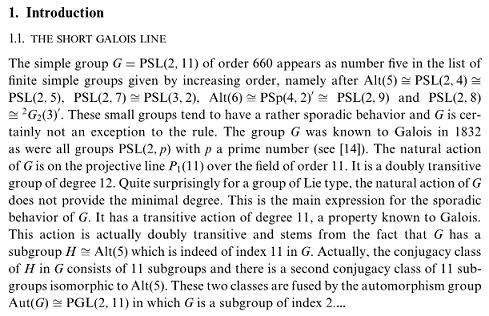
|
Comments Off on Tuesday July 14, 2009
Monday, July 13, 2009
Comments Off on Monday July 13, 2009
Saturday, July 11, 2009
Comments Off on Saturday July 11, 2009
Wednesday, July 8, 2009
Comments Off on Wednesday July 8, 2009
Monday, June 29, 2009
Calvinist Epiphany
for St. Peter’s Day
“Have your people
call my people.“
— George Carlin
Diamond life, lover boy;
we move in space
with minimum waste
and maximum joy.
— Sade, quoted here on
Lincoln’s Birthday, 2003
This is perhaps suitable
for the soundtrack of
the film “Blockheads“
(currently in development)–

Diamond Life —
Related material from Wikipedia:
“Uta Frith, in her book Autism: Explaining the Enigma,[5] addresses the superior performance of autistic individuals on the block design [link not in Wikipedia] test. This was also addressed in [an] earlier paper.[6] A particularly interesting article demonstrates the differences in construction time in the performance of the block design task by Asperger syndrome individuals and non-Asperger’s individuals. An essential point here is that in an unsegmented version of the task, Asperger’s individuals performed dramatically faster than non-Asperger’s individuals: [7].”
5. Frith, Uta (2003). Autism: explaining the enigma (2nd ed. ). Cambridge, MA: Blackwell Pub. ISBN 0-631-22901-9.
6. Shah A, Frith U (Nov 1993). “Why do autistic individuals show superior performance on the block design task?”. J Child Psychol Psychiatry 34 (8): 1351–64. PMID 8294523.
7. Caron MJ, Mottron L, Berthiaume C, Dawson M (Jul 2006). “Cognitive mechanisms, specificity and neural underpinnings of visuospatial peaks in autism”. Brain 129 (Pt 7): 1789–802. doi:10.1093/brain/awl072. PMID 16597652. “Fig 3”.
Comments Off on Monday June 29, 2009
Thursday, June 25, 2009
“… T. S. Eliot tried to recompose,
in
Four Quartets, the fragments
he had grieved over
in
The Waste Land.”
— “Beauty and Desecration,”
Roger Scruton
(link at aldaily.com today)
| “The formula reproduces exactly the essential features of the symbolic process of transformation. It shows the rotation of the mandala, the antithetical play of complementary (or compensatory) processes, then the apocatastasis, i.e., the restoration of an original state of wholeness….”
— Carl G. Jung in Aion
|
Related material:
Comments Off on Thursday June 25, 2009
Monday, June 22, 2009
Text
Today’s birthday:
Kris Kristofferson
Online Etymology Dictionary
-
-
1369, “wording of anything written,” from O.Fr. texte, O.N.Fr. tixte (12c.), from M.L. textus “the Scriptures, text, treatise,” in L.L. “written account, content, characters used in a document,” from L. textus “style or texture of a work,” lit. “thing woven,” from pp. stem of texere “to weave,” from PIE base *tek- “make” (see texture).
“An ancient metaphor: thought is a thread, and the raconteur is a spinner of yarns– but the true storyteller, the poet, is a weaver. The scribes made this old and audible abstraction into a new and visible fact. After long practice, their work took on such an even, flexible texture that they called the written page a textus, which means cloth.” [Robert Bringhurst, “The Elements of Typographic Style”]
Text-book is from 1779.
|

“Discuss the geometry
underlying the above picture.”
— Log24, June 11, 2009
Comments Off on Monday June 22, 2009
Thursday, June 11, 2009
Geometry for Jews
(continued from Michelangelo’s birthday, 2003)

“Discuss the geometry underlying the above picture.”
— Log24, March 6, 2003
Abstraction and the Holocaust (Mark Godfrey, Yale University Press, 2007) describes one approach to such a discussion: Bochner “took a photograph of a new arrangement of blocks, cut it up, reprinted it as a negative, and arranged the four corners in every possible configuration using the serial principles of rotation and reversal to make Sixteen Isomorphs (Negative) of 1967, which he later illustrated alongside works by Donald Judd, Sol LeWitt and Eva Hesse in his Artforum article ‘The Serial Attitude.’ [December 1967, pp. 28-33]” Bochner’s picture of “every possible configuration”–
Compare with the 24 figures in Frame Tales
(Log24, Nov. 10, 2008) and in Theme and Variations.
Comments Off on Thursday June 11, 2009
Thursday, June 4, 2009
New collection release:
Pattern in Islamic Art
from David Wade
David Wade has partnered with ARTstor to distribute approximately 1,500 images of Islamic art, now available in the Digital Library. These images illustrate patterns and designs found throughout the Islamic world, from the Middle East and Europe to Central and South Asia. They depict works Wade photographed during his travels, as well as drawings and diagrams produced for publication. Reflective of Wade's particular interest in symmetry and geometry, these images analyze and break down common patterns into their basic elements, thereby revealing the underlying principles of order and balance in Islamic art. Islamic artists and craftsmen employed these intricate patterns to adorn all types of surfaces, such as stone, brick, plaster, ceramic, glass, metal, wood, and textiles. The collection contains examples of ornamentation from monumental architecture to the decorative arts.
To view the David Wade: Pattern in Islamic Art collection: go to the ARTstor Digital Library, browse by collection, and click "David Wade: Pattern in Islamic Art;" or enter the Keyword Search: patterninislamicart.
For more detailed information about this collection, visit the David Wade: Pattern in Islamic Art collection page.
|
The above prose illustrates
the institutional mind at work.
Those who actually try to view
the Wade collection will
encounter the following warning:
| To access the images in the ARTstor Digital Library you need to be affiliated with a participating institution (university, college, museum, public library or K-12 school). |
Comments Off on Thursday June 4, 2009
Thursday, May 28, 2009
Spelling
At right below, an image from the opening of Fox Studios Australia in Sydney on November 7, 1999. The Fox ceremonies included, notably, Kylie Minogue singing “Diamonds are a Girl’s Best Friend.”
|
Red Windmill

|
Kylie Minogue

|
For the mathematical properties of the red windmill (moulin rouge) figure at left, see Diamond Theory.
|
“There comes a time when you have
learned enough to decide whether
the way of the Craft is for you….
First you will need to
prepare your sacred space….
Calling the Corners (or Quarters)
is something you will always do.”
Happy birthday, Kylie.
Comments Off on Thursday May 28, 2009
Friday, May 22, 2009
Steiner System
New York Times
banner this morning:

Click to enlarge.
Related material from
July 11, 2008:

|
The HSBC Logo Designer —
Henry Steiner
 He is an internationally recognized corporate identity consultant. Based in Hong Kong, his work for clients such as HongkongBank, IBM and Unilever is a major influence in Pacific Rim design. He is an internationally recognized corporate identity consultant. Based in Hong Kong, his work for clients such as HongkongBank, IBM and Unilever is a major influence in Pacific Rim design.
Born in Austria and raised in New York, Steiner was educated at Yale under Paul Rand and attended the Sorbonne as a Fulbright Fellow. He is a past President of Alliance Graphique Internationale. Other professional affiliations include the American Institute of Graphic Arts, Chartered Society of Designers, Design Austria, and the New York Art Directors' Club.
His Cross-Cultural Design: Communicating in the Global Marketplace was published by Thames and Hudson (1995).
— Yaneff.com
|
Charles Taylor,
"Epiphanies of Modernism,"
Chapter 24 of Sources of the Self
(Cambridge U. Press, 1989, p. 477):
"… the object sets up
a kind of frame or space or field
within which there can be epiphany."
|
Related material suggested by
an ad last night on
ABC's Ugly Betty season finale:


Diamond from last night's
Log24 entry, with
four colored pencils from
Diane Robertson Design:

See also
A Four-Color Theorem.
Comments Off on Friday May 22, 2009
Wednesday, May 20, 2009
From Quilt Blocks to the
Mathieu Group M24
Click on illustrations for details.
The connection:
The relationship of S(5,8,24) to the finite geometry PG(3,2) has also been discussed in–
- "A Geometric Construction of the Steiner System S(4,7,23)," by Alphonse Baartmans, Walter Wallis, and Joseph Yucas, Discrete Mathematics 102 (1992) 177-186.
Abstract: "The Steiner system S(4,7,23) is constructed from the geometry of PG(3,2)."
- "A Geometric Construction of the Steiner System S(5,8,24)," by R. Mandrell and J. Yucas, Journal of Statistical Planning and Inference 56 (1996), 223-228.
Abstract: "The Steiner system S(5,8,24) is constructed from the geometry of PG(3,2)."
Comments Off on Wednesday May 20, 2009
Tuesday, May 19, 2009
Exquisite Geometries
"By far the most important structure in design theory is the Steiner system S(5, 8, 24)."
— "Block Designs," 1995, by Andries E. Brouwer
"The Steiner system S(5, 8, 24) is a set S of 759 eight-element subsets ('octads') of a twenty-four-element set T such that any five-element subset of T is contained in exactly one of the 759 octads. Its automorphism group is the large Mathieu group M24."
— The Miracle Octad Generator (MOG) of R.T. Curtis (webpage)
"… in 1861 Mathieu… discovered five multiply transitive permutation groups…. In a little-known 1931 paper of Carmichael… they were first observed to be automorphism groups of exquisite finite geometries."
— William M. Kantor, 1981
The 1931 paper of Carmichael is now available online from the publisher for $10.
Comments Off on Tuesday May 19, 2009
Sunday, May 17, 2009
Design Theory
"My work is motivated by a hope that there may be a way to recapture the ancient and medieval vision of both Beauty and purpose in a way which is relevant to our own century. I even dare to hope that the two ideas may be related, that Beauty is actually part of the meaning and purpose of life."
Hans Ludwig de Vries, "
On Orthogonal Resolutions of the Classical Steiner Quadruple System SQS(16),"
Designs, Codes and Cryptography Vol. 48, No. 3 (Sept. 2008) 287-292 (DOI 10.1007/s10623-008-9207-5)–
"The Reverend T. P. Kirkman knew in 1862 that there exists a group of degree 16 and order 322560 with a normal, elementary abelian, subgroup of order 16 [1, p. 108]. Frobenius identified this group in 1904 as a subgroup of the Mathieu group M24 [4, p. 570]…."
1. Biggs N.L., "T. P. Kirkman, Mathematician," Bulletin of the London Mathematical Society 13, 97–120 (1981).
4. Frobenius G., "Über die Charaktere der mehrfach transitiven Gruppen," Sitzungsber. Königl. Preuss. Akad. Wiss. zu Berlin, 558–571 (1904). Reprinted in Frobenius, Gesammelte Abhandlungen III (J.-P. Serre, editor), pp. 335–348. Springer, Berlin (1968).
Olli Pottonen, "Classification of Steiner Quadruple Systems" (Master's thesis, Helsinki, 2005)–
"The concept of group actions is very useful in the study of isomorphisms of combinatorial structures."
"Simplify, simplify."
— Thoreau
"Beauty is bound up
with symmetry."
— Weyl

Pottonen's thesis is
dated Nov. 16, 2005.
For some remarks on
images and theology,
see Log24 on that date.
Click on the above image
for some further details.
Comments Off on Sunday May 17, 2009
Wednesday, May 6, 2009
Joke
“My pursuits are a joke
in that the universe is a joke.
One has to reflect
the universe faithfully.”
— John Frederick Michell
Feb. 9, 1933 –
April 24, 2009
“I laugh because I dare not cry.
This is a crazy world and
the only way to enjoy it
is to treat it as a joke.”
— Robert A. Heinlein,
The Number of the Beast
For Marisa Tomei
(born Dec. 4, 1964) —
on the day that
Bob Seger turns 64 —
A Joke:
Points All Her Own
Points All Her Own,
Part I:
(For the backstory, see
the Log24 entries and links
on Marisa Tomei’s birthday
last year.)

Points All Her Own,
Part II:
(For the backstory, see
Galois Geometry:
The Simplest Examples.)

Points All Her Own,
Part III:
(For the backstory, see
Geometry of the I Ching
and the history of
Chinese philosophy.)

In simpler terms:
Smackdown!

Comments Off on Wednesday May 6, 2009
Sunday, May 3, 2009
Michell, who wrote on Glastonbury
(a site associated with King Arthur)
and on sacred geometry, seems to
have had a better education than
most sacred-geometry enthusiasts.
He is said to have studied at
Eton and at Trinity College,
Cambridge.
He is not to be
confused with an earlier
Trinity figure, mathematician
John Henry Michell,
who died at 76 on the third
day of February in 1940.
Related material:
See the Log24 entry
from the date of death
of the later Michell —
April 24 —
and, in light of the later
Michell’s interest in
geometry and King Arthur,
the Log24 remarks for
Easter Sunday this year
(April 12).
These remarks include the
following figure by
Sebastian Egner related,
if only through myth,
to Arthur’s round table —

— and the classic Delmore Schwartz
poem “Starlight Like Intuition
Pierced the Twelve.”
Which of the two John Michells
(each a Merlin figure of sorts)
would be more welcome in
Camelot is open to debate.
Comments Off on Sunday May 3, 2009
Thursday, April 23, 2009
Comments Off on Thursday April 23, 2009
Friday, April 17, 2009
Begettings of
the Broken Bold
Thanks for the following
quotation (“Non deve…
nella testa“) go to the
weblog writer who signs
himself “Conrad H. Roth.”
|
… Yesterday I took leave of my Captain, with a promise of visiting him at Bologna on my return. He is a true
A PAPAL SOLDIER’S IDEAS OF PROTESTANTS 339
representative of the majority of his countrymen. Here, however, I would record a peculiarity which personally distinguished him. As I often sat quiet and lost in thought he once exclaimed “Che pensa? non deve mai pensar l’uomo, pensando s’invecchia;” which being interpreted is as much as to say, “What are you thinking about: a man ought never to think; thinking makes one old.” And now for another apophthegm of his; “Non deve fermarsi l’uomo in una sola cosa, perche allora divien matto; bisogna aver mille cose, una confusione nella testa;” in plain English, “A man ought not to rivet his thoughts exclusively on any one thing, otherwise he is sure to go mad; he ought to have in his head a thousand things, a regular medley.”
Certainly the good man could not know that the very thing that made me so thoughtful was my having my head mazed by a regular confusion of things, old and new. The following anecdote will serve to elucidate still more clearly the mental character of an Italian of this class. Having soon discovered that I was a Protestant, he observed after some circumlocution, that he hoped I would allow him to ask me a few questions, for he had heard such strange things about us Protestants that he wished to know for a certainty what to think of us.
|
Notes for Roth:

The title of this entry,
“Begettings of the Broken Bold,”
is from Wallace Stevens’s
“The Owl in the Sarcophagus”–
This was peace after death, the brother of sleep,
The inhuman brother so much like, so near,
Yet vested in a foreign absolute,
Adorned with cryptic stones and sliding shines,
An immaculate personage in nothingness,
With the whole spirit sparkling in its cloth,
Generations of the imagination piled
In the manner of its stitchings, of its thread,
In the weaving round the wonder of its need,
And the first flowers upon it, an alphabet
By which to spell out holy doom and end,
A bee for the remembering of happiness.
Peace stood with our last blood adorned, last mind,
Damasked in the originals of green,
A thousand begettings of the broken bold.
This is that figure stationed at our end,
Always, in brilliance, fatal, final, formed
Out of our lives to keep us in our death....
|
Related material:
Some further context:
Roth’s entry of Nov. 3, 2006–
“Why blog, sinners?“–
and Log24 on that date:
“First to Illuminate.”
Comments Off on Friday April 17, 2009
Thursday, April 16, 2009
Comments Off on Thursday April 16, 2009
Friday, April 10, 2009
Pilate Goes
to Kindergarten
“There is a pleasantly discursive
treatment of Pontius Pilate’s
unanswered question
‘What is truth?’.”
— H. S. M. Coxeter, 1987,
introduction to Trudeau’s
remarks on the “Story Theory“
of truth as opposed to the
“Diamond Theory” of truth in
The Non-Euclidean Revolution
Consider the following question in a paper cited by V. S. Varadarajan:
E. G. Beltrametti, “Can a finite geometry describe physical space-time?” Universita degli studi di Perugia, Atti del convegno di geometria combinatoria e sue applicazioni, Perugia 1971, 57–62.
Simplifying:
“Can a finite geometry describe physical space?”
Simplifying further:
“Yes. Vide ‘The Eightfold Cube.'”
Comments Off on Friday April 10, 2009
« Newer Posts —
Older Posts »





























































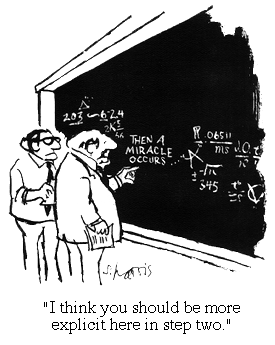
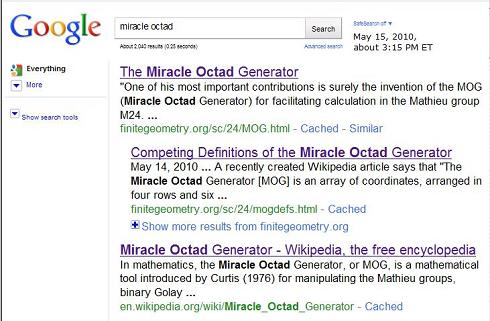


















































































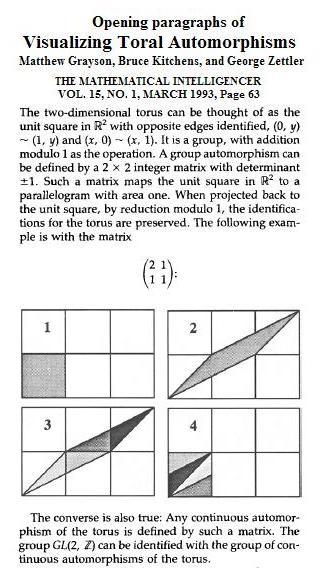
















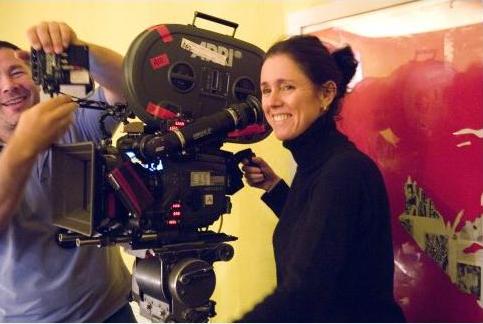




























 He is an internationally recognized corporate identity consultant. Based in Hong Kong, his work for clients such as HongkongBank, IBM and Unilever is a major influence in Pacific Rim design.
He is an internationally recognized corporate identity consultant. Based in Hong Kong, his work for clients such as HongkongBank, IBM and Unilever is a major influence in Pacific Rim design.
















